This post was originally published on Real Progressives.
-
Comments and responses on the Modern Money Primer Part 14.
-
Comments and responses on the Modern Money Primer Part 11.
This post was originally published on Real Progressives.
-
The front-page headline of the December 11, 2023, Washington Post (WAPO) read, “China’s cyber army is invading critical U.S. services.” The sub-headline, “A utility in Hawaii, a West Coast port and a pipeline are among the victims in the past year, officials say,” impressed upon the reader that the Peoples Republic of China had wriggled its way into causing havoc in America’s industrial system. Carefully read the article and learn that nothing unusual has happened to critical U.S. services and there are no facts to indicate anything unusual will happen. The headlined article is a far-fetched opinion piece masquerading as an explosive investigation that urges critical attention to an exaggerated problem. Addressing this exaggeration may seem trivial but it tells the story of how the government gathers information to make faulty decisions and that is not trivial. Please excuse if the response to the article sounds sarcastic at times, but the article has comedic appearances that invite ridicule.
How do we know this is an exaggerated problem; a succeeding paragraph tells us nothing happened, and, after casually informing us there have been no disruptions, the authors take a five thousand mile leap to tie together a trivial hacking and the brewwwwwwiiiiing conflict in Taiwan.
None of the intrusions affected industrial control systems that operate pumps, pistons or any critical function, or caused a disruption, U.S. officials said. But they said the attention to Hawaii, which is home to the Pacific Fleet, and to at least one port as well as logistics centers suggests the Chinese military wants the ability to complicate U.S. efforts to ship troops and equipment to the region if a conflict breaks out over Taiwan.
Without citing a fact that relates some trivial hacking to a diabolical scheme or showing the hacking was more than a nuisance, the article informs us that the hacking, “suggests the Chinese military wants the ability to complicate U.S. efforts to ship troops and equipment to the region if a conflict breaks out over Taiwan.”
Did this read correctly: “Chinese military wants the ability to complicate U.S. efforts to ship troops and equipment to the region if a conflict breaks out over Taiwan?” Fellow Americans, do you know that our government intends to send troops to fight for Taiwan? Don’t be concerned, any war in Taiwan will be over before any ship left U.S. waters with battle-ready American soldiers ready to fight the yellow peril.
Who are these hackers? “Hackers affiliated with China’s People’s Liberation Army have burrowed into the computer systems of about two dozen critical entities over the past year, experts said.” ‘Affiliated’ is a vague word and, without having specifics, there is doubt that China’s People’s Liberation Army knew about the hacking.
The imagination of the government sources that provided the information for the article does not just leap continents, it reaches into the barren outer space with over-dosed suppositions.
Some of the victims compromised by Volt Typhoon were smaller companies and organizations across a range of sectors and “not necessarily those that would have an immediate relevant connection to a critical function upon which many Americans depend,” said Eric Goldstein, CISA’s executive assistant director. This may have been “opportunistic targeting … based upon where they can gain access” — a way to get a toehold into a supply chain in the hopes of one day moving into larger, more-critical customers, he said.
The hackers are looking for a way to get in and stay in without being detected, said Joe McReynolds, a China security studies fellow at the Jamestown Foundation, a think tank focused on security issues. “You’re trying to build tunnels into your enemies’ infrastructure that you can later use to attack. Until then you lie in wait, carry out reconnaissance, figure out if you can move into industrial control systems or more critical companies or targets upstream. And one day, if you get the order from on high, you switch from reconnaissance to attack.”
Lots of words that say the cyberattacks have accomplished nothing but could be a training ground for more advanced activities, similar to shooting ducks could be terrorist training for shooting down airplanes.
Adding zero information to zero information forms a mighty conclusion.
The disclosures to The Post build on the annual threat assessment in February by the Office of the Director of National Intelligence, which warned that China “almost certainly is capable of launching cyberattacks that would disrupt U.S. critical infrastructure, including oil and gas pipelines and rail systems.
The report, which shows some Chinese have basic knowledge of cyberattacks, leads to a conclusion of major capability ─ China “almost certainly is capable of launching cyberattacks that would disrupt U.S. critical infrastructure, including oil and gas.” To my knowledge, no strategic facility is on the Internet; they are all on private networks and cannot be hacked unless the hacker sets up transceivers around the facility that can intercept the communications, decode them, retrieve vital information, such as passwords, and transmit hacking messages into the networks computers. This is a complicated procedure and is difficult to shield from exposure. No revelations that “hackers affiliated with China’s People’s Liberation Army” have set up shop around the private networks have been mentioned.
This investigation of the investigation may sound trivial and provoke a big yawn and a “so what.” Don’t be fooled, the WAPO article reveals a major problem confronting Americans ─ U.S. foreign policies are not developed from facts and reality; they are developed from made-up stories that fit agendas. Those who guide the agendas solicit support from the population by providing made-up and exaggerated stories that rile the American public and define its enemies. This diversion from facts and truth is responsible for the counterproductive wars fought by the U.S., for Middle East turmoil, for a world confronted with terrorism, and for the contemporary horrors in Ukraine and Gaza. U.S. foreign policy is not the cause of all the problems, but it intensifies them and rarely solves any of them.
U.S. administrations have been involved in much of China’s internal affairs — Taiwan, Hong Kong, Tibet, South China Sea, Belt and Road, Uyghurs — without showing how China’s internal affairs affect the U.S. and why the U.S. and not Tanzania should be involved. What has this interference accomplished? Nothing! Absolutely nothing, and, except for the South China Sea disputes, nothing that arouses concerns seems to be occurring. If the U.S. administrations spent time, energy, and tax dollars on affairs more directly connected with U.S. operations, they may learn that their obsession with China’s affairs hindered acceptable resolutions and prevented attention to their own and more meaningful problems. Oh, and it might prevent World War III.
The post Troublesome China Bashing first appeared on Dissident Voice.This post was originally published on Dissident Voice.
-
US congressional commission has called for Li Qiaochu’s release, citing reports she needs urgent medical treatment
Li Qiaochu, a human rights activist detained for nearly three years in China, has gone on trial in Shandong province charged with “inciting subversion of state power”.
On the eve of the trial the chairs of the US congressional commission on China called for Li’s unconditional release, citing reports that the labour rights and feminist activist needed urgent medical treatment.
Continue reading…This post was originally published on Human rights | The Guardian.
-
Hu Zimo in Bitter Winter of 12 December 2023 tells bout Peng Lifa. He is the “Bridge Man” who on October 13, 2022, managed to hang two banners with anti-Xi-Jinping slogans on Beijing’s Sitong Bridge. He was promptly arrested and his present whereabouts are unknown. [see also: https://humanrightsdefenders.blog/2023/09/05/human-rights-lawyer-gao-zhisheng-and-the-practice-of-enforced-disappearances-joint-letter/]
Less well-known is the name of painter Xiao Liang, although “Bitter Winter” reported in December 2022 that he had been detained for “painting the portrait of a dangerous person.” The “dangerous person” was Peng Lifa. At that time, neither “Bitter Winter” nor the painter’s wife and friends knew what exactly happened to Xiao Liang after the police took him away from his home in Nanchang city, Jiangxi province. But the repressive system of the CCP did not forget him.
On December 7, 2022, Xiao was formally arrested by the Donghu District Procuratorate of Nanchang City with the accusation of “picking quarrels and provoking trouble,” now a popular charge against all kind of dissidents. His wife was submitted to long interrogations as the police tried to prove that Xiao was part of an organized anti-CCP group.
Relatives and friends have now learned and posted on social media that Xiao was sentenced to one year and three months in jail for the crime of “picking quarrels and provoking trouble.” In addition to his portrait of Peng Lifa, the painter was considered a “troublemaker” by the authorities for his paintings and posters supporting the Ukrainian resistance against Russia, a staunch ally of the Chinese regime.
https://bitterwinter.org/xiao-liang-dissident-painter-was-sentenced-to-1-year-and-3-months-in-jai
This post was originally published on Hans Thoolen on Human Rights Defenders and their awards.
-
This week’s News on China.
Sources:
• China calls for a “roadmap” to a two-state solution
The post China Calls for a “Roadmap” to a Two-state Solution first appeared on Dissident Voice.
“China calls for ceasefire, UN peace conference to end Israel-Gaza conflict”
“Israeli military widens ground offensive to southern Gaza”
“PA thanks China for sending aid to Gazans in hour of need: Palestinian diplomat”
• US Secretary of Commerce counters China’s development
“US commerce chief warns against China ‘threat’”
“Raimondo’s remarks expose deep-rooted Cold War mentality: FM”
• Chinese cancer drug costs 31 times more in the US
“China’s new cancer drug Toripalimab is approved in the US but will cost 30 times more”
• ReelShort and the “microdrama” trend
“China’s micro-drama craze shows potential of ‘sheconomy’ abroad”
“海外“吸金”、股票大涨……看似风光的微短剧是实火还是虚火“This post was originally published on Dissident Voice.
-

On 8 December, 2023 Jake Werner – Acting Director of the East Asia program at the wrote an interesting piece “Outrage Without Strategy Means Failure on China and Human Rights”. It makes in my view some very valid points, see for yourself:
The deplorable human rights record of the Chinese government has long featured in U.S. political discourse as an example of that venerable trope, the heroic individual demanding freedom from the tyrannical state. U.S. leaders quite naturally align themselves with the advocates of freedom, coming to their aid by repudiating and punishing their tormentors.
The antagonism between civil society and the state highlighted in this view is undeniably true, but this truth is only partial. Its seeming clarity threatens to obscure the complexities of Chinese politics and U.S.–China relations in ways that may produce counterproductive responses.
The political journey of a friend of mine in recent years illustrates dynamics excluded from the conventional human rights framing. I first met Zhao (a pseudonym) a decade ago while doing research in Shanghai, when both of us were grad students interested in leftist politics. I joined a reading group he was running with other Chinese grad students and we discussed ideas that posed a deep challenge to Chinese social and political inequalities.
In the years since, his critical energies have increasingly flowed away from inequalities within China to focus instead on the inequality between what he sees as a domineering United States and a victimized China. Increasingly he deems the Chinese government as the champion of the beleaguered Chinese people, whose opportunity to rise in wealth and status is being harshly circumscribed by jealous American leaders. To him, “human rights” is a fig leaf for the defense of naked U.S. power and a feature of western culture foisted on countries like China, whose level of development makes it inappropriate.
It was not state propaganda that moved Zhao in this direction — when we first connected he was already perfectly capable of seeing through official Communist Party narratives. Instead, it was heavy–handed U.S. behavior, tendentious U.S. narratives that refuse to give any credit to the Chinese system, and the glaring hypocrisy of American leaders harshly condemning Chinese abuses while remaining silent on the abuses of countries U.S. leaders are cultivating to counter China.
From Zhao’s experience, we can discern additional truths: that U.S. human rights rhetoric is not impartial but is a feature of geopolitical rivalry; that this fact threatens to discredit the whole idea of human rights in the eyes of many Chinese; that the Chinese government strategy of casting human rights defenders as agents of U.S. power rather than advocates of universal values may in the process find considerable success among Chinese citizens.
Yet Zhao’s truths are also selective. Other friends of mine bear witness to the reality not only of Chinese government repression but the dramatic expansion of that repression in both quantitative and qualitative terms over the last decade. The labor activist forced to move to Hong Kong to continue his work after the crackdown on worker rights, only to be hounded from Hong Kong when the mainland government crushed its democracy movement. The Uyghur scholar detained under atrocious conditions, forced to recite loyalty oaths that only poisoned him against the regime. The feminist activists studying overseas, wracked with fear that even outside the country they will suffer terrible consequences for criticizing officials’ increasingly open misogynistic policies.
The vision of human freedom and dignity expressed in the Universal Declaration of Human Rights provides a standard against which to judge the Chinese political system. Many of those same principles are enshrined in the Chinese constitution, making the argument that they are alien to Chinese culture untenable. By both measures, the Chinese government falls far short.
Yet neither document provides a strategy to achieve human freedom and dignity. In formulating such a strategy, moral truths are necessary but inadequate. The truths of power politics and psychological dynamics must be incorporated as well.
We in America need to reflect on some uncomfortable truths. As much as we might wish to see ourselves as an agent of global justice, other countries and their citizens do not always share this view. The conflict with China is not only an ethical dispute but is also a power struggle over which country will dominate East Asia militarily and the world economically. The United States is not just criticizing Chinese repression, but is actively seeking to limit China’s global influence.
Where does this leave U.S. policy on China? First, deploying human rights as a resource in geopolitical conflict is more likely to inspire cynicism around the idea of human rights than it is to vindicate the claim to higher values.
Second, because geopolitics makes national rivalry the most salient axis of political conflict, it is singularly ill–suited to advancing the human rights project. A geopolitics focused on U.S. global primacy encourages an alignment between China’s government and the Chinese people against threatening foreign forces. Under such circumstances, Chinese leaders are more likely to see those within China who defend human rights as the agents of alien ideas and alien interests, and can more convincingly portray them as such. Linking human rights efforts to geopolitical conflict strengthens those forces in China and the United States that are most hostile to human rights — forces such as nationalism, xenophobia, and militarism.
A U.S. strategy on human rights in China should begin by reducing the prominence of geopolitical division in U.S.–China relations. This would help to shape a domestic environment in China (and the United States) that would open space for human rights advocacy. America’s longstanding punitive and coercive approach to human rights promotion has failed everywhere it has been tried. The danger of such an approach is magnified in a moment when great power tension threatens to spin out of control.
It is more urgent than ever to formulate a more strategic approach. By stepping away from the commitment to global primacy as the centerpiece of U.S. foreign policy, a foreign policy of restraint offers new ways to approach human rights that avoid the pitfalls of associating universal rights with the power machinations of specific countries.
https://quincyinst.org/2023/12/08/addressing/
This post was originally published on Hans Thoolen on Human Rights Defenders and their awards.
-
The UK, US and Canada are announcing a sweeping package of sanctions targeting individuals linked to human rights abuses around the world, ahead of the 75th anniversary of the Universal Declaration of Human Rights on 10 December.
UK targets forced labour operations in Southeast Asia, and government-linked officials in Belarus, Haiti, Iran, and Syria complicit in repressing individual freedoms.
The first set targets 9 individuals and 5 entities for their involvement in trafficking people in Cambodia, Laos and Myanmar, forcing them to work for online ‘scam farms’ which enable large-scale fraud. Victims are promised well-paid jobs but are subject to torture or other cruel, inhuman, or degrading treatment…
The second is aimed at a number of individuals linked to the governments, judiciaries and prosecuting authorities of Belarus, Haiti, Iran, and Syria, for their involvement in the repression of citizens solely for exercising fundamental freedoms in those countries.
Included in the USA sanctions are two Afghanistan government ministers accused of repressing women and girls, by restricting access to secondary education; two Iranian intelligence officers who the Treasury says plot violence against Iranian regime opponents beyond the nation’s borders and two Chinese officials accused of torturing Uyghur ethnic minorities in the Xinjiang region of China.
https://www.gov.uk/government/news/uk-and-allies-sanction-human-rights-abusers
This post was originally published on Hans Thoolen on Human Rights Defenders and their awards.
-
Jails in China and Britain | Katherine Rundell | Gentleman and the Garrick | Dear pandas | Low hum | No FA Cup levelling up
Reading another article about Chinese prisoners possibly making products for sale in the UK (Chinese prisoner’s ID card apparently found in lining of Regatta coat, 1 December), I wonder why there is no concern that British prisoners are forced to work for UK companies for about 50p an hour? This work provides no training for release and serves only to enrich private prison contractors.
David Adams
Darlington, County Durham• How appropriate that on the day you note that Katherine Rundell, the author of The Golden Mole, has won the Waterstones book award with Impossible Creatures (Report, 30 November), we also learn of a golden mole reappearing after being feared extinct (Report, 30 November).
Continue reading…
Jim Golcher
Greens Norton, NorthamptonshireThis post was originally published on Human rights | The Guardian.
-
10 Mins Read

At a major APAC food tech conference in Singapore last month, I spoke to four alt-meat founders from India, China, the Philippines and Australia to find out what Asian consumers want from plant-based meat products.
Last month, as part of the Singapore International Agri-Food Week (SIAW), the Asia-Pacific Agri-Food Innovation Summit organized by Rethink Events welcomed over 1,000 global leaders to meet and learn about Asia’s agri-food system to “accelerate the transition to a climate-smart food system” as organizer Rethink Events states on the event website.
As part of the week’s programming, I chaired a discussion about the ‘Healthier Proteins Shaping the Future for Plant-Based Innovation’ on stage. Joining me were four founders and leaders from plant-based meat startups in the APAC region, each representing some of the biggest markets in India, China, the Philippines and Australia, as well as the APAC Science and Technology Director from one of the world’s leading flavour companies.
Our discussion spanned a range of topics, from how important are clean labels to whether Asian consumers are still actively purchasing these products. We talked about what factors influence decision-making, what new ingredients are being developed in the sector, and what brands can do to build confidence in the nutritional value and overall quality of plant-based products
Most of all, the question we were trying to answer was: what does the Asian plant-based consumer want? The key takeaway from the discussion is that each Asian market is unique and its consumers have very specific and very different needs.
The below transcriptions have been edited for clarity and concision.
Anand Nagarajan, Co-Founder at Shaka Harry on Indian Consumers

Courtesy: Shaka Harry On the Indian plant-based meat consumer: India is not one market. We’ve got 1.4 billion people, so it’s important not to view the Indian market as one ubiquitous market. The relationship to meat is complicated. In terms of who our consumer is, we have a very simple definition: anyone who has an affinity for the taste of meat is the consumer we’re looking for. We are going after the two-thirds of Indians who eat meat. Culturally, a large percentage of the Indian population that still consumes meat would abstain from it for close to 150 days of the year for various reasons. Some people abstain from meat on certain days. Some people will not eat meat at home. Some people only eat meat when they travel. Some people won’t eat meat on festival days. But all these people may want something that’s a familiar taste. This is where we position Shaka Harry.
On creating products for specific occasions: How do we create salience in a customer’s life, rather than trying to over-intellectualize the conversation? If something needs a lot of education…it won’t scale. We can’t educate a billion people individually. Even if I were to take the 100-200 million high-end consumer market, I can’t sit down and educate every single one of them. Instead, we focus on occasions. How do I win breakfast? How do I win school lunch prep? How do I win at a Saturday family gathering? We’re saying: here’s a very good product, it’s priced well and it is tasty. We’ll give you an occasion for when you need to have this at home. And we find that a far easier method to scale, rather than pursuing micro-markets.
On whether Indians want healthier products: Do Indian consumers want healthier products? There’s a disconnect between what the consumer tells you they want versus what they’re ready to pay for. When they go into the store, and you give them two products, one being healthier but with a 20-30% price premium, they will choose the value product. That’s what we are seeing.
On We have an entire line of clean-label products coming out soon with easy-to-read, natural ingredients. Thanks to consumer insights, we’ve developed a millet range. Millets is something that traditionally Indians have consumed a lot and consumers have very positive connotations about it. But here the point is not to mimic a meat experience. Rather we’re saying: here’s a very good product. We’re going to ‘de-junk’ your regular roti and paratha. We’re taking the gluten out. We’re adding natural fiber. The initial market response has been fantastic. So de-junking regular meals and giving consumers a superior version of everyday foods is working really well.
Shaka Harry is a plant protein company based out of India with a range of ready-to-eat products designed for the Indian palate and for Indian cuisines.
Astrid Prajogo, Founder and CEO at Haofood on Chinese Consumers

Haofood co-founder Astrid Prajogo exhibited the new peanut-based pork dumplings in Berlin | Courtesy: Haofood/LinkedIn On the Chinese consumer base: Our consumer base is very interesting. They’re not flexitarian, but they’re gym-goers. So they choose our product because they are looking for specific protein with specific features- that’s one type of consumer that is pretty loyal to us. We also have the forein vegan community. Although not a large group, they have strong purchasing power. They also have a voice, which can be powerful. Finally, we have the local Chinese vegan community as well, they continue to support our products.
On what Chinese consumers are looking for from meat: We have spent the last couple of years studying how Chinese consumers approach buying meat. Not just plant-based meat, just meat. That’s what we want to understand. And taste is absolutely key, especially umami. China is the land of tasty food, every single part of the country has great-tasting food. So first: taste – they demand great taste. Second is safety. McKinsey published research earlier this year that revealed that for Chinese consumers, health and safety are the most important. Part of safety is for a product not to contain ingredients that consumers deem less safe, like methylcellulose or added gums so our definition of clean-label is free from added artificial ingredients, be it binders or perseveratives. We combine different types of plant proteins and we work with fruit fibres, so we can make a clean-label product where the cost is actually reasonable- we’re down to under $3.5 per kilogram.
Haofood is a Shanghai-based specialist in Asian plant-based meat designed for Asian applications.
Stephen Michael, Co-Founder and CEO at WTH Foods on Filipino consumers

Courtesy WTH Foods The Philippines is a pretty sizable country- we have over 110 million Filipinos, and it’s a very meat heavy culture. As a predominantly Catholic country, we don’t have any dietary restrictions, so I’m jealous of my Thai and Malaysian friends whose vegetarian market exists already. In the Philippines, it’s almost non-existent and that’s what we are up against. Culturally and traditionally, a lot of dishes are meat-based, so putting out a plant-based meat product might not be the best idea. We’re continuously trying to figure out what the Filipino consumer wants. It seems they see something as healthy when it is local with added functional benefits in terms of beauty or physical aspects. So for example, if plant-based meat products are helpful for slimming, or if eating these products can help radiate beauty- that’s a driver. The entry point for the Filipino market is health, more than whether something is plant-based. Sustainability and animal welfare are very, very far down the list in terms of our consumers adopting plant-based meat.
When Filipinos think about health, they go for descriptive words like ‘organic’ or ‘cholesterol-free’, ‘low sodium’, ‘low fat’, ‘low sugar. Adding to that, Filipino consumers want their food to be more fortified or to have a unique ingredient like a local oil. For example, we’re trying mungbeans as an additive to respond to that demand- it’s a local and natural ingredient. to add a more local and natural ingredient to that. Consumers want to avoid preservatives and flavor enhancers so they do look at the ingredient list and want a cleaner label as well. For more of our plant-based meats, we fortify with local proteins or local ingredients to give them a more local and healthier profile.
There’s actually been a bit of pushback with plant-based meats when we offer Filipino favourites like sisig and sausages and holiday hams, where Filipinos will go for the real thing instead of the plant-based version, which has been a difficult scenario. So we’re done pretending to be meat. Achieving something as close to meat as possible will require that long list of ingredients and our customers are looking at labels, and if they don’t understand certain ingredients, they deem it to be less healthy. So we are actually in the midst of a pivot in terms of products. We are decreasing the number of our ingredients for our second generation of products and we don’t try so hard to be the meat product. I believe in the alternative protein industry and I believe there will be increased demand and need for protein, so we’re looking into high-protein snacks in more shelf-stable formats. The Philippines is an archipelago shipping frozen meat across all the islands is a logistical nightmare. So it’s a triple challenge: how do you ship your products across an archipelago, while making them shelf-stable and reducing the number of ingredients so they can be clean-label?
WTH Foods is a plant-based alternative protein startup based in Manila.
Chris Coburn, General Manager APAC at v2food on Australian plant-based meat consumers

Courtesy: v2food On why Australia is different from the rest of Asia: I would say Australia is a little bit different from the rest of Asia, where I think we’re still seeing animal protein as being aspirational. Consumers in the rest of the region are looking to purchase animal products now that there’s more wealth available and a growing middle class. In Australia, as in a number of the developed markets, we’re seeing this trend to be a reducetarian, where people who have reached peak meat consumption are probably looking to come back the other way. If you look at animal consumption per capita in Australia, obviously it’s at levels that are close to the UK and US, unlike the rest of Asia.
On v2foods’ Australian consumer base: I would say v2food’s consumer base is the conscious consumers, those who are looking to reduce their meat intake, so we have a different challenge to the rest of Asia. Probably half of our retail sales are from this younger demographic -the millennials / the single-income-no-kids / the double-income-no-kids / those coming into families over the next 10 years- those conscious consumers looking to reduce meat consumption and consume alternatives.
On clean labels: I think from a portfolio point of view, we’re looking at the clean-label issue in two different ways and trying to distinguish from those more indulgent occasions where consumers are looking for that great taste and probably a treat and those everyday occasions where people are looking for more healthy options. In the first group of our products, we have burgers and sausages, and we’re competing against animal protein products which are highly processed, and for those, we are really trying to drive taste as the priority for our target consumers. Our biggest fear is that sometimes our competitors’ products are not good, and consumers are having a bad experience. So we really feel like taste is important for the category of products like sausages, burgers, and nuggets.
v2food is Australia’s number-one plant-based meat company.
Ai Mey Chuah, APAC Science & Technology Director at Givaudan Singapore on Asian Consumer Tastes

Courtesy: Givaudan Ultimately for our customers, the most important thing is taste. If their products don’t taste good, and don’t look appealing, they won’t get a repurchase by the consumers. So in our business, what we do is customize the solutions to meet the needs of their consumers from the regions that they are marketing their products to.
I would say that in APAC cost is still a very important factor. So while for our Europe and US business, clean-label and natural solutions are very important, for the APAC region cost is still the determining factor- we help our clients change their label to be more cost-effective, rather than clean-label, as our [clean-label] solutions tend to be more expensive.
Some markets like China have well-educated consumers who don’t like artificial ingredients or additives in their products, so when it comes to replacing ingredients like methylcellulose, Asia is slowly gaining traction and we have products in our portfolio like citrus fibre that can act synergistically with certain proteins to actually provide that texture that is meat-like, juicy and succulent.
Givaudan is a global leader in fragrance and flavour; the company develops tastes and scents for food companies all over the world.
The post What Do Asian Consumers Want From Plant-Based Meat? 4 Startup Founders Spill All. appeared first on Green Queen.
This post was originally published on Green Queen.
-
What were the most important achievements of the Morrison government? I asked Microsoft Bing chat. Alongside managing the COVID-19 pandemic, the AI chatbot nominated AUKUS, the trilateral security pact between Australia, the United Kingdom, and the United States. The pact aims to bolster deterrence and cooperation in the Indo-Pacific region. The US and Australia are…
The post Home-grown AI is a key building block for our future appeared first on InnovationAus.com.
This post was originally published on InnovationAus.com.
-
This week’s News on China.
Sources:
The post No New “Epidemic” in China first appeared on Dissident Voice.
• Spike in respiratory illnesses
“China Tells WHO Known Germs Are Causing Surge in Child Pneumonia”
“Upsurge of respiratory illnesses among children-Northern China”
• Taiwan opposition parties run on separate tickets
“Taiwan opposition parties register separate bids for presidential race in a boost for DPP and a worry for mainland China”
“Taiwan election: KMT’s Hou Yu-ih climbs in polls after collapse of joint ticket, but DPP’s William Lai still leads”
• Negative FDI for the first time
“How much FDI is China actually attracting?”
“Foreign investment in China turns negative for first time”
• Renewable energy plants in deserts
“China’s Remote Deserts Are Hiding an Energy Revolution“This post was originally published on Dissident Voice.
-
Derbyshire woman who bought item said she felt uneasy at find that raises concerns over possible prison labour
An ID card that appears to belong to a Chinese prisoner was found inside the lining of a coat from the British brand Regatta, raising concerns that the clothing was manufactured using prison labour.
The waterproof women’s coat was bought online by a woman in Derbyshire in the Black Friday sale. When it arrived on 22 November, she could feel a hard rectangular item in the right sleeve, which restricted the movement of her elbow.
Continue reading…This post was originally published on Human rights | The Guardian.
-
As peer-level adversaries develop and deploy hypersonic weapons while the United States and its allies look to match and counter those capabilities, a new frontier in strategic weapon systems is emerging. Hypersonic weapons – typically glide vehicles deployed by ballistic missile or cruise missiles that exceed Mach 5 – have emerged as the latest technological […]
The post High-End Threat: The Accelerating Pace of Hypersonic Weapons appeared first on Asian Military Review.
This post was originally published on Asian Military Review.
-
Submarines are undergoing a renaissance in the Asia-Pacific region. Excluding mini-submarines, approximately 230 are in service. With a growing naval superpower present in the Asia-Pacific region, demand for submarines is expected to increase, as a ThyssenKrupp Marine Systems (TKMS) spokesperson explained, they have “…the capability to occupy large numbers of opposing forces through their mere […]
The post Submarines Resurgent appeared first on Asian Military Review.
This post was originally published on Asian Military Review.
-
9 Mins Read
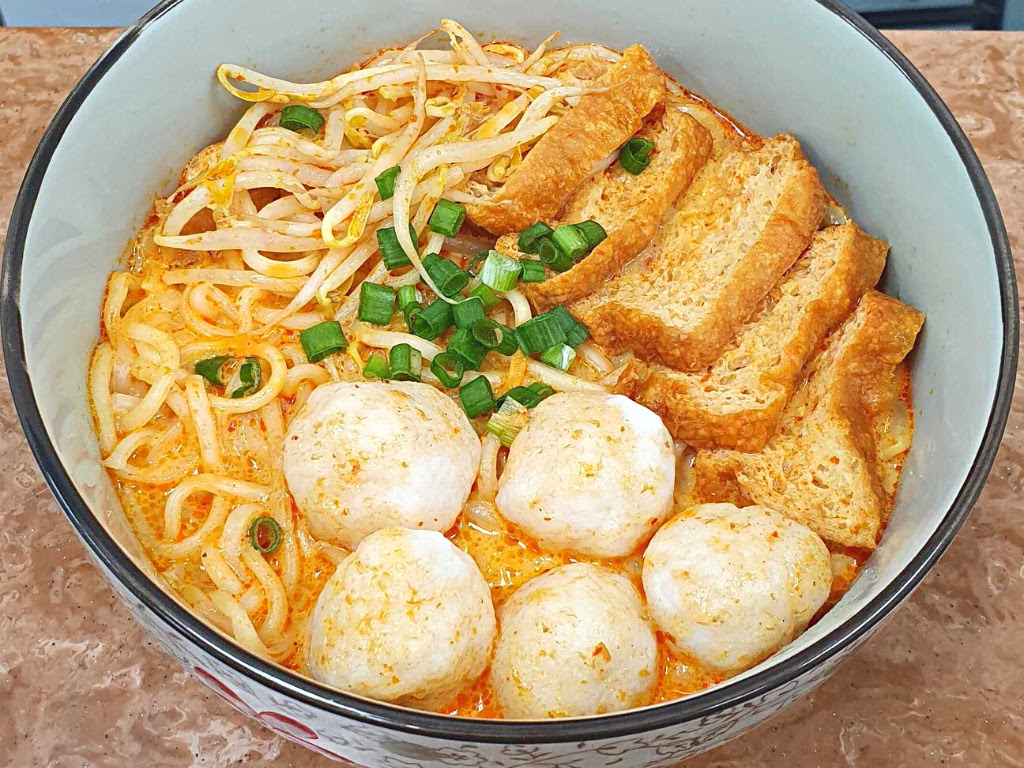
A new report by Asymmetrics Research outlines the opportunity for protein diversification in China, highlighting key active categories, overall trends and what’s in store for the future for alternative proteins in the country.
In August, research by Singapore-based firm Asia Research Engagement found that to align with a climate-safe future and decarbonise, alternative proteins would need to make up 50% of China’s protein consumption by 2060. It came amid a host of advancements in the country’s alt-protein sector, across cultivated meat, fermentation-derived protein, and plant-based food.
Now, Asymmetrics Research has published the third edition of its annual China Alternative Protein Products Market Landscape report, which highlights the key trends, challenges and opportunities for protein diversification in the world’s second-most populous nation.
“This year has been challenging in a China that is fraught with uncertainty – consumers, businesses and investors are generally spending more conservatively,” Huiyi Lin, chief insights officer at Asymmetrics Research, told Green Queen. “Nonetheless, there are opportunities for food products which offer good value both in cost and health benefits.”
She added: “Brands need to probe different consumer segments’ motivation and turn-off factors, and ultimately food needs to taste good. Fermentation and cell-culture protein technologies are at an early stage, the growth path would require support from regulators and commercial scaling partners.”
“In the post-pandemic era, consumers are placing greater emphasis on nutritional value and affordability,” said Jeremy Yeo, acting general manager of Beyond Meat China. “Additionally, there’s a pronounced shift towards products that prioritise health, flavour and environmental sustainability. ‘Green’ and eco-friendly options are not mere trends; they mark a profound evolution in consumer tastes and values.”
Here are 10 key takeaways from the China Alternative Protein Products Market Landscape report:
Alt-protein investment has been slower in 2023
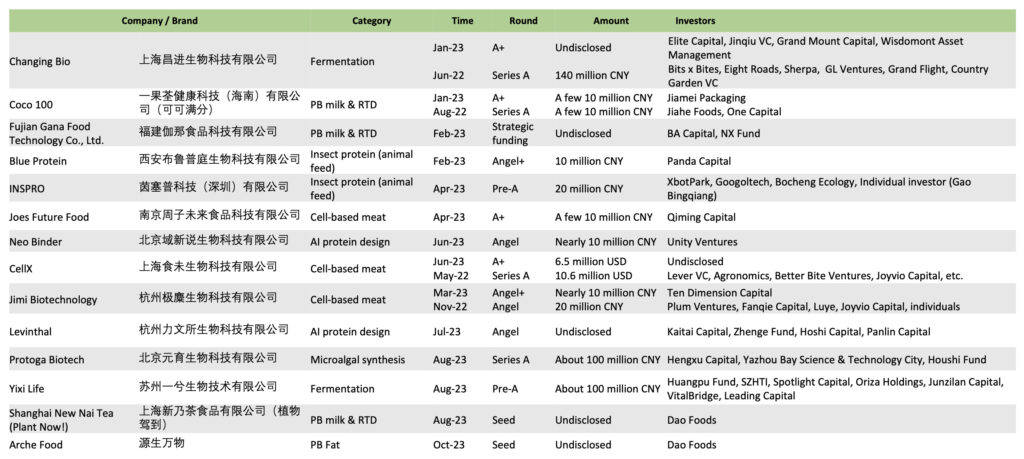
Courtesy: Asymmetrics Research Amid the wider investment squeeze in the global food tech category, China’s alt-protein industry has also suffered from a slower funding environment, which has been exacerbated by tough fundraising and macroeconomic conditions. Local investors are less bullish about CPG categories including food, while foreign investors are adopting a wait-and-see approach “due to geopolitical tensions, decoupling strategies and uncertainty”.
Plant-based meat – which had a relatively high deal flow in 2021 and 2022 – saw fewer investments in the past year, while larger deals have involved cultivated and fermentation startups. Interest in cultivated meat has increased due to high-level policy callouts, but it has been affected by cautious sentiments this year. Eventual investors usually tend to be experienced in biomedical fields. Additionally, Chinese meat giants are said to be interested in acquiring cultivated meat startups, but no such acquisitions have been made yet.
“Cell-based meat is gaining more attention in the capital market, and R&D and manufacturing costs will continue to fall with technological progress,” said Larry Lee, CEO of the China Plant-Based Foods Association.
Plant-based milk, meat snacks and functional foods are key segments – but eggs and cheese are not
The report highlights a few key active categories, led by plant-based milk and ready-to-drink beverages, alt-meat snacks, SKUs and prepared meals, vegan yoghurt and ice cream, and functional protein foods. However, despite being the largest egg producer in the world, vegan egg replacement is a less active category, alongside cheese and cream.
“China’s plant-based milk market is experiencing a blend of tradition and innovation,” said Vivian Wang, founder and CEO of plant milk brand Vitalbox. “Enzymatic hydrolysis oat milk coexists with traditional soy milk and coconut milk.”
Alt-meat and milk brands are restructuring and diversifying

Courtesy: Asymmetrics Research As a result of slow market penetration, high marketing costs and fundraising difficulties, the plant-based milk and meat markets have seen a reduced number of players, with many brands also restructuring adjusting their portfolios and brand positioning, and diversifying their offerings.
Echoing the global stagnation of plant-based meat, several startups in this space have downsized, suspended operations, or exited the market. Many multinational vegan players have changed team structures, personnel and strategies, but remain committed to the market. “The market will need more high quality, diversified protein products,” said Cecilia Zhao, impact programme manager at food consultancy Lever China.
“Although adoption of plant-based meat in China lags behind Western markets, there is a dedicated consumer base motivated by health, safety and dietary diversity, necessitating solutions to taste, additives and cost issues,” added Astrid Prajogo, founder and CEO of Haofood. “Targeting specific consumer groups with customised products and marketing approaches holds great promise in this evolving market.
Health consciousness is high on the agenda
Brands are honing in on the health aspects of their products – similar to the shift seen in the international market – with marketing messages a key outlet for doing so. Many plant-based milk brands highlight ‘no sugar/cholesterol/trans fat’, ‘good for brains/eyes’, and ‘high protein/calcium’ alongside cleaner labels, while some use functional ingredients like DHA, collagen and peptide to target specific consumer needs.
Likewise, plant-based meat products highlight attributes like ‘no trans fat/cholesterol’, ‘fewer calories’, ‘dietary fibre’ and ‘natural ingredients’. It chimes with the results from a 1,206-person study last year, which found that health is the stronger driver of plant-based meat purchases for Chinese consumers.
“China is promoting healthier and more nutritious food options in response to the Healthy China policy,” said David J Ettinger, chief representative officer at law firm Keller and Heckman Shanghai. “Therefore, foods offering health benefits and high nutritional value are going to likely lead the way. Chinese consumers will look to healthier options, like alt-proteins, so it will be up to the alt-protein industry to demonstrate that these novel foods provide another nutritious option for consumers.”
Prices and spending are in full focus
Across the country, many middle-income consumers are now reining in their spending on impulse purchases and looking for better value on products. Prices of pork and beef have fallen, which has ramped up the challenge for plant-based brands trying to sell to food service, which is a cost-sensitive approach. Many have lowered their product prices by 10-30% in the last year as a result.
Raw milk prices have dropped too, which means initiatives like Starbucks offering oat and almond milk at price parity are paramount. “Overall, consumers are more price-sensitive,” noted Blue Canopy Biotech’s Chenfeng Lu. “Despite this, the consumption of healthy foods is not strongly affected by the economic environment.”
Oat milk reigns supreme
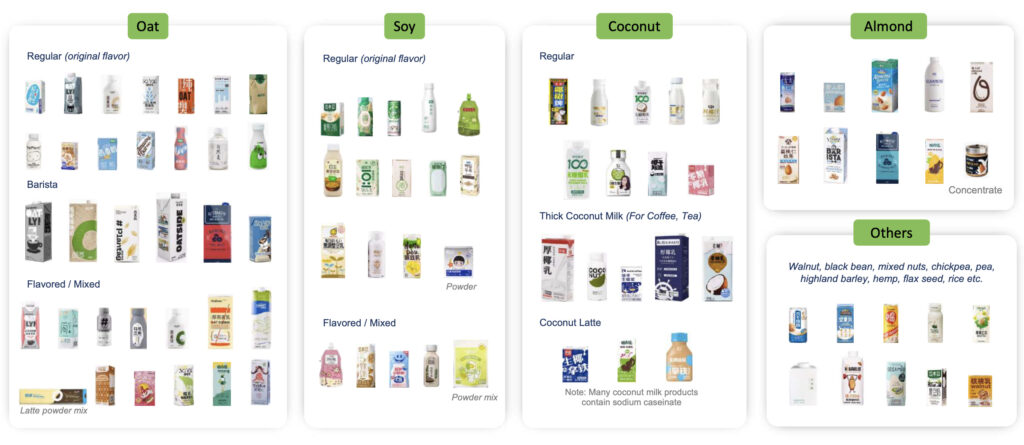
Courtesy: Asymmetrics Research Despite soy being the traditional milk alternative in China, oat milk has really risen up the ranks and now leads the way in terms of form and flavours, with the widest product range out of all plant-based milks. This is followed by soy, coconut, almond and a smattering of others.
Oat milk’s utility in coffee is a big reason for its dominance. Most barista milk products that highlight ‘frothability’ as a key feature are oat-based, and thanks to brands like Oatly and Luckin Coffee, tier 1 and 2 cities have seen oat (and coconut) become common latte choices – though the report highlights an expansion of B2B applications beyond coffee as a key challenge.
“The market is still in its early stage,” said Oatly China’s sustainability director, Chloe Lin. “It is crucial to educate and guide consumers, listen to local consumer needs, work closely with upstream and downstream value chain, and conduct in-depth research in raw material quality, processing technology, production equipment, product taste and nutrition.” (The company has had its share of struggles in China recently.)
Education and regulation remain major hurdles for fermentation
Both biomass and precision fermentation have attracted interest, but product application needs to be stepped up, and production needs scaling. Most companies are focused on a single type of fermentation tech, but firms like Changing Bio and Blue Company are among the few working with both precision and biomass fermentation.
Some startups do have a diversified portfolio, with products and applications in cosmetics, industrial and biomedical sectors too. The report calls for increased application for B2B consumers, including functional products and blended meat (like Mush Foods is doing).
Precision fermentation, in particular, needs increased consumer awareness and regulatory approval, especially when it comes to GMOs. In May 2022, China’s National Health Commission approved single-cell green alga Chlamydomonas reinhardtii as a new food raw material in May 2022 – a positive sign, albeit for a non-GMO ingredient.
Cultivated pork and traditional meats are high-priority

Courtesy: CellX As the world’s largest pork producer, it’s hardly a surprise that pork is the most popular cultured meat being produced in China, followed by chicken, beef and seafood. Companies like CellX and Joes Future Food are making cell-cultured pork, while Jimi Biotech makes cultivated chicken.
Additionally, some producers are making high-priced animal parts used in traditional Chinese cuisine, such as deer antlers (Jimi Biotech) and fish maw (Avant Meats).
Cost and regulation are key barriers for cultured meat
As is the case globally, scaling up production and reducing costs are the main obstacles facing cultivated meat (alongside regulatory approval). CellX opened a 2,000-litre pilot facility in August, while Joes Future Food produced pork fat in a 500-litre bioreactor in September. Meanwhile, some are developing serum-free or non-animal culture media to reduce costs – Jimi Biotech’s serum-free medium is made from soybean and corn extracts.
Meanwhile, China doesn’t have a clear regulatory framework, something that’s still under review by the National Health Commission and China National Center for Food Safety Risk. This is why some companies are focusing on Singapore or the US – the only two countries that have approved the sale of cultivated meat.
Policy support for alt-protein in China has increased
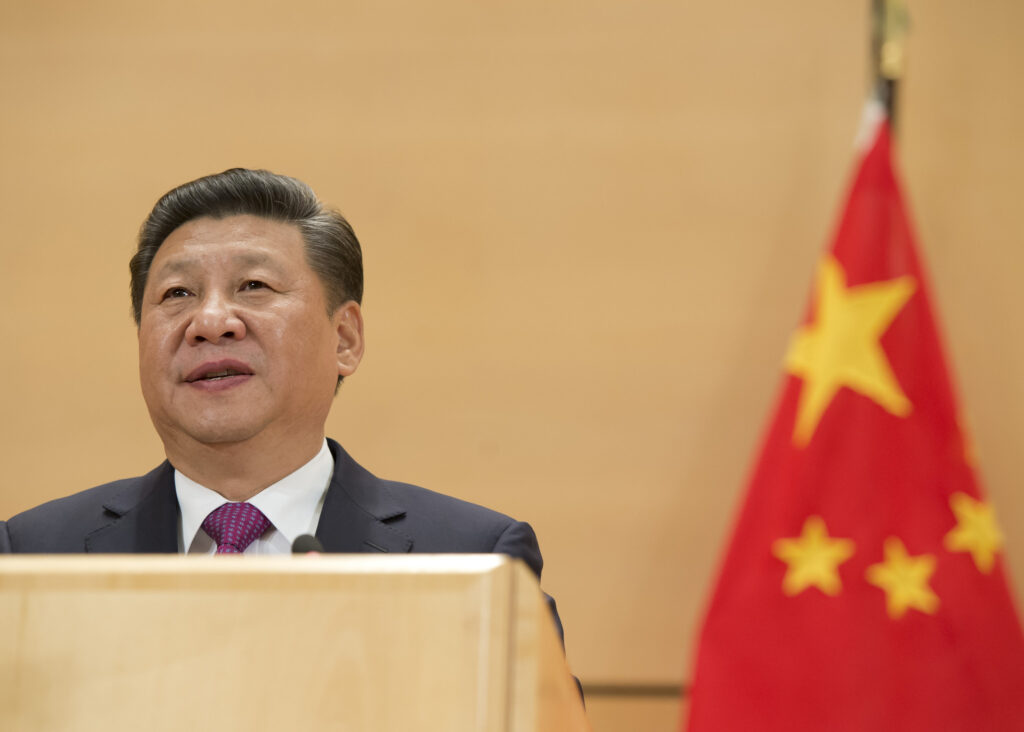
Courtesy: UN Geneva/CC Government support for alt-protein has become more prominent in the last two years in China, with measures being formed at local, provincial and regional levels. In February, for example, the annual Central No. 1 Document mentioned a diversified food system of animals, plants and microorganisms.
In May 2022, the country’s 14th five-year plan for bioeconomy development highlighted an advancement of synthetic biology, and exploration of man-made protein and novel foods – two months after President Xi Jinping called for a Grand Food Vision that included the plant-, microorganism- and animal-based protein sources. And in December 2021, the 14th five-year plan for agricultural and rural tech development called for research in cultivated meat, synthetic egg and dairy, and recombinant proteins.
“Government guidance and policy support is necessary – it would be best to have subsidies for start-ups and R&D institutions to raise the level of innovation,” said Lee from the China Plant Based Foods Association. “Investors should be more patient, avoid following trends blindly with unrealistic expectations of rapid returns. Companies should focus on the product based on consumer needs, step up R&D, improve product quality and differentiation.”
“In the post-pandemic slower growth environment, alternative protein players with products in the market need to provide tasty and high-value offerings, which fulfil specific consumer segments’ health and nutritional wants,” added Huiyi. “In the longer term, new technologies of fermentation and cell-based culture, and blended products hold interesting possibilities.”
The post China Alt-Protein: 10 Things to Know About Protein Diversification in China – New Report appeared first on Green Queen.
This post was originally published on Green Queen.
-
BEIJING: Over 40 countries including Pakistan and China set up their national stalls featuring a range of cultural activities such as traditional music as well as a display of art, costumes, and cuisines at the annual International Culture Day organized by Pakistan Embassy College (PECB) here on Sunday.
According to APP, the Pakistan Ambassador to China, Khalil Hashmi inaugurated the event as the chief guest.
Ambassadors, senior diplomats, officials, media representatives and students along with their families, and members of the Pakistani and international community participated in this cultural gala.China, Russia, Italy, Rumania, Ukraine, Saudi Arabia, Sudan, Libya, Bulgaria, Bangladesh, Nepal, Tajikistan, Azerbaijan and several other countries showcased their cultural handcrafts, products, and traditional cuisines.
Ambassador Hashmi visited stalls and exhibitions set up by students and their parents and appreciated them for showcasing handicrafts, foods, and culture of their respective countries.
There were fun areas and gaming zones for children. Cultural performances of various countries were also presented which were greatly enjoyed by the guests.
Ambassador Hashmi in his address commended the PECB and its students for excellent organization and for presenting the rich kaleidoscope of performances which advanced mutual understanding, respect and collaboration among different cultures and traditions.
He described culture a powerful tool to build bridges and foster friendships between nations.
Ambassador Hashmi also underlined the significance of International Culture Day celebrations for China Pakistan relations, noting that the event served as a platform to promote the creation of China-Pakistan Community of Shared Future.Principal, Shazia Amjad welcomed the audience and expressed gratitude for their keen interest and enthusiastic participation.
Some exquisite dance performances on tunes of Pakistan’s traditional music, stunning Pakistani and Chinese songs and cultural dresses mesmerized the audience.Pakistani food, handicrafts and traditional dresses showcased to highlight and promote Pakistani culture attracted a lot of attention from the participants.
Ambassador Hashmi and his wife cut a cake along with the principal, teachers and students to mark the special occasion. The students were also given gifts through lucky draw.The International Culture Day is celebrated every year by PECB to highlight the institution’s core values of mutual learning, respect and cooperation.
The post Annual International Culture Day organized at Pakistan Embassy College Beijing first appeared on VOSA.
This post was originally published on VOSA.
-
Three U.S. presidents were instrumental in establishing Thanksgiving as a regular national event. On October 3, 1789, George Washington declared the first federal Thanksgiving holiday. In 1863, Abraham Lincoln made it an annual federal holiday. And in 1941, Franklin Roosevelt signed a bill setting the date at the fourth Thursday of every November. All three presidents were giving thanks for bringing the country through a major financial crisis related to war, and they all achieved this feat through what Sen. Henry Clay called the “American system” of banking and finance – sovereign or government-issued money and credit.
For Washington, the challenge was freeing the American colonies from the imperial rule of Britain, then the world’s leading military power, when the new government lacked a source of funding. Lincoln faced a similar challenge, leading the Northern states in a civil war while lacking a national bank or national currency to fund it. For Roosevelt, the challenge was bringing the country through the Great Depression and World War II, when 9,000 banks had gone bankrupt at the beginning of his first term and the country was again without a source of credit.
In 1796, after 20 years of public service, George Washington warned in his farewell address to “cherish public credit” and avoid “accumulation of debt,” and to “avoid foreign entanglements” (“steer clear of permanent alliances with any portion of the foreign world”). He would no doubt be alarmed to see where we are 227 years later. We have a federal debt of $33.7 trillion, bearing an interest tab of nearly $1 trillion annually — over one-third of personal tax receipts. And we have a military budget from “foreign entanglements” that is also approaching one trillion dollars, devouring more than half the annual discretionary budget. Meanwhile, according to the American Society of Civil Engineers, the country is in serious need of infrastructure funding, tallied at $3 trillion or more; but our debt-strapped Congress has no appetite or capacity for further infrastructure outlays.
However, Washington, Lincoln and Roosevelt faced financial challenges that were equally daunting in their day; and the country came through them and continued to thrive, using a funding device that Benjamin Franklin described as “a mystery even to the politicians.”
Hamilton’s Revolutionary Fix: Debt-for-Equity Swaps
To fund the Revolutionary War, the Continental Congress resorted to simply issuing the money as paper receipts for goods and services, as the colonial governments had done with their paper scrip. It was this that Franklin wrote was “a mystery even to the politicians, how we could pay with paper that had no previously fixed fund appropriated specifically to redeem it.” He said, “This currency as we manage it is a wonderful machine.” Thomas Paine called it a “cornerstone” of the Revolution.
But the Continental dollar was not a pure fiat currency. It was “a zero-interest bearer bond.” That means it was a debt, which had to be repaid. By the end of the Revolutionary War, the new government was $77 million in debt — $40 million in domestic debt, $12 million in foreign debt, and $25 million in state debt incurred in the Revolution — with no apparent means of repayment.
Alexander Hamilton, Washington’s Treasury Secretary, solved the problem with debt-for-equity swaps. State debt was accepted in partial payment for stock in the First Bank of the United States (BUS), paying a 6% dividend. The rest was to be paid in gold. The Bank leveraged this capital into credit, issued as the first U.S. currency.
BUS loans were based on the fractional reserve model. Hamilton wrote, “It is a well established fact, that Banks in good credit can circulate a far greater sum than the actual quantum of their capital in Gold & Silver.” That was the model of the Bank of England (BOE), the financial engine of the oppressors; but there were fundamental differences between the BUS and BOE models. The BOE was privately owned and was operated for private profit. It was chartered to be an instrument of government policy capitalized exclusively by public debt. The government would pay the private lenders, who controlled what policies could be funded. What early American economists called the “British System” was geared to exploiting the colonies through “free trade” and the government through usurious interest payments.
Hamilton’s BUS, by contrast, was to be a commercial bank, funding itself by generating credit for public works. Its primary purpose, following Hamilton’s Report on Public Credit, was to issue credit to the government and private interests for internal improvements and other economic development. Hamilton said a bank’s function was to generate active capital for agriculture and manufactures, increasing the quantity and quality of labor and industry. The BUS was intended to establish a sovereign currency, a banking system, and a source of credit to build the nation, creating productive wealth, not just financial profit.
It was thus a national development bank, and so was the Second BUS chartered after the First BUS charter expired. Infrastructure and productivity flourished during that period, including completion of the Erie Canal. But Pres. Andrew Jackson thought only silver or gold coins qualified as an acceptable medium of exchange. He declared war on the bank and shut it down, leaving the country without a national currency or source of national credit for nearly three decades.
Lincoln’s Greenbacks and the National Bank Act
When President Lincoln came into office, he was faced with the prospect of a crippling war debt to British-backed banks at 24% to 36% interest. To avoid that “re-conquest by debt,” his government returned to the practice of the American colonists: it issued U.S. Notes or “Greenbacks,” actually doubling the money supply. The National Bank Act was also passed, allowing banks in the national banking system to issue National Bank Notes backed by the U.S. Treasury. To join the system, banks had to capitalize their banknotes in part with government debt.
These new monies funded not only the war effort but rapid economic development. Most famous was completion of the Transcontinental Railroad, linking both sides of the nation by 1869 and returning a profit to the government. The telegraph system developed beside the railroad; railroad track expanded; and freight tonnage between New York and Chicago grew 75%. By the end of the war, 90 trains entered Chicago every day (vs. none in 1850). Factory output boomed, and mechanization allowed agriculture to flourish, despite one million men being under arms. The money supply was doubled but did not trigger price inflation after the war, because supply and demand rose together, keeping prices in balance.
The Federal Reserve and “Checkbook Money”
But Lincoln was assassinated, the Greenbacks were discontinued, silver was demonetized, and a deep depression followed. A major banking crisis in 1906 led to passage in 1913 of the Federal Reserve Act, modeled on the Bank of England. The twelve Federal Reserve Banks are all 100% owned by the private banks in their districts. The national currency is issued as “Federal Reserve Notes,” which are lent or sold to private banks and bond dealers. Rather than issuing dollars, the U.S. government issues debt (bonds, bills and notes), which it sells on the open market to the bond dealers at interest.
Today private banks rather than the government issue most of the money supply by creating dollars on their books as loans. That practice dates back to the post-civil-war era. Before the 1860s, banks printed paper promissory notes called “banknotes” that were redeemable in gold or “real bills” (promises to deliver goods in the future). These notes were then lent to borrowers. Real bills could not be leveraged, since they were specific to particular goods; but gold could be and was, leading to bank runs when customers doubted their bank’s ability to repay all the claims against its gold. The National Bank Act stabilized that system by maintaining the value of National Bank Notes from state to state.
In an effort to get state-chartered banks to join the national banking system, the National Bank Act imposed a heavy tax on their banknotes. But many banks avoided the tax by replacing banknotes with checkbooks: the loan amount was just written into the borrower’s account as a “deposit,” and the borrower wrote his own promissory note in the form of “checkbook money.” These deposits are counted in the money supply, and that is how banks now “create money” – nearly all of it.
FDR and the Reconstruction Finance Corporation
The Federal Reserve was supposed to prevent bank runs by providing reserves, but it obviously failed in that endeavor. The early 1930s saw the worst contagion of bank runs in history. Loose credit in the 1920s triggered speculative bubbles on leveraged borrowing; and when the bubble inevitably burst in the Crash of 1929, liquidation of assets was forced on the borrowers. Depositors rushed to withdraw funds, triggering runs; 9,000 banks failed; and $7 billion in deposits were frozen. The money supply shrank, yet the Fed did not intervene.
To stimulate the economy and restore jobs, FDR’s government therefore reverted to Hamilton’s “American System.” The Reconstruction Finance Corporation (RFC), set up by President Hoover to save the banks, was repurposed and greatly expanded to leverage credit for manufacturing and development. Begun with a modest $500 million in capitalization, the RFC lent or invested over $40 billion from 1932 to 1957. It funded the New Deal and World War II and returned a net profit to the government of $690 million.
The RFC was not a depository bank and did not take deposits. For liquidity it issued bonds, most of which were bought by the federal government. The RFC then made loans to local governments and productive small businesses at below-market rates. To repay the loans, cities that were over their general obligation bond limits issued “revenue bonds,” repaid with the revenues generated by the works funded by the loans.
The RFC provided off-budget funding. According to James Butkiewicz, professor of economics at the University of Delaware:
The RFC was an executive agency with the ability to obtain funding through the Treasury outside of the normal legislative process. Thus, the RFC could be used to finance a variety of favored projects and programs without obtaining legislative approval. RFC lending did not count toward budgetary expenditures, so the expansion of the role and influence of the government through the RFC was not reflected in the federal budget.
The Chinese Economic Miracle
Today the stellar model for infrastructure development is China, which went from one of the poorest countries in the world to global economic powerhouse in four decades. Among other achievements, between 2008 and 2019 China built 18,000 miles of high-speed rail, along with the world’s largest dam and power station. How was all that funded? The government owns 80% of Chinese banking assets, including three massive “policy banks” designed to carry out the policies of the government. Government-owned banks fund the projects with credit, and fees generated by the projects repay the loans.
Predominant among the policy banks is China Development Bank (CDB), the largest development bank in the world. It has a national network of local branches to coordinate policies and projects; but like the RFC, it does not take private savings. Rather, it issues bonds. CDB bonds make up 25% of the national bond market, second only to those of the Ministry of Finance (the Chinese Treasury). CDB bonds have a credit rating as high as the government’s and are in high demand.
China’s publicly-owned banks issued so much credit for infrastructure and development that its money supply (M2) actually grew 2900% in the last 27 years, yet hyperinflation did not result. Why? China’s GDP shot up in tandem, keeping supply and demand in balance.
Development Banks to the Rescue
China’s massive infrastructure development has been credited with pulling the world out of the Great Recession, and its current tack is to repeat that effort. In 2022, the Chinese government pledged the yuan equivalent of $120 billion to the policy banks for infrastructure funding to revive the economy.
We could do that too — revive the U.S. economy with a self-funding National Infrastructure Bank. H.R.4052, the National Infrastructure Bank Act of 2023, follows the Hamiltonian model. For capital, it proposes debt-for-equity swaps with federal bondholders, adding a 2% dividend on top of the bond payouts for enticement. The swap would be bonds for non-voting bank shares, which could be swapped back for the bonds after twenty years. Unlike the RFC, the NIB is proposed to be a depository bank, able to leverage its capital to create deposits as loans on its books. Cities could repay these low-interest loans with revenue bonds funded by the infrastructure they create, as in the 1930s.
Abundance is the hallmark of Thanksgiving, and affordable credit is the key to abundance. If we can duplicate the feats of Washington, Lincoln, and FDR, we can turn debt into equity for an infrastructure bank that generates low-cost credit for development and create an abundant economy we can be thankful for!
* This article was first published in Scheer Post.
This post was originally published on Dissident Voice.
-
Islamabad: Ministry of foreign affairs has confirmed that Pakistan has made a formal request to join BRICS, which it believes is an important grouping of developing countries.
Responding to queries of journalists at media briefing, ministry of foreign affairs spokesperson said that Pakistan enjoys friendly ties with most of the members of BRICS, as well as the newly invited group of countries.
“Pakistan is also an ardent supporter of multilateralism and is a member of several multilateral organizations,” spokesperson said adding that it has played an important role for global peace and development.
“Pakistan is an important developing country and has made important contributions in promoting peace, solidarity and cooperation among countries of the south.”
“We have taken this decision after having noted the BRICS related developments in Johannesburg and its proclaimed openness to inclusive multilateralism.
“We believe by joining BRICS, Pakistan can play an important role in furthering international cooperation and revitalization of inclusive multilateralism. We also hope that BRICS will move forward on Pakistan’s request in line with its commitment to inclusive multilateralism,” spokesperson commented.
To a query with regard to UNHCR statement on illegal immigrants’ deportation, spokesperson said that current drive to implement Pakistan’s immigration laws is focused on individuals who are residing here illegally.
“It does not apply to individuals who are here on refugee status,” spokesperson said adding that UNHCR has the mandate to deal with refugees.
“We agree that refugees who are in Pakistan shall return to their home country in honour and dignity through a consultative process, which is a tripartite consultative process between Pakistan, Afghanistan, and UNHCR,” spokesperson commented.
The post Pakistan makes a formal request to join BRICS: Ministry of foreign affairs first appeared on VOSA.
This post was originally published on VOSA.
-
Islamabad: Federal caretaker minister for commerce and industry Dr. Gohar Ejaz received the ambassador of China to Pakistan Jiang Zaidong for a meeting to discuss Pakistan-China economic cooperation especially in fields of trade and Investment.
The focus of the discussions revolved around the implementation of the China-Pakistan Economic Corridor (CPEC), which has now entered its second stage.
Dr. Ejaz informed the ambassador that the first phase of CPEC is at an advanced age at inter-governmental level which has helped Pakistan to develop the infrastructure, road network, power plants to meet energy needs, and now the time has come for the private sectors of both countries
The post Chinese Ambassador meets Pakistan’s commerce minister to discuss bilateral trade first appeared on VOSA.
This post was originally published on VOSA.
-
Ding Jiaxi and Xu Zhiyong are leading figures in the thwarted New Citizens’ Movement group of activists and lawyers
A Chinese court is to rule in the appeals of detained human rights lawyers Ding Jiaxi and Xu Zhiyong, as Ding’s wife called on China’s top judge to “rectify the miscarriage of justice” in their case.
Ding and Xu are leading figures in China’s thwarted New Citizens’ Movement, a loose network of activists and lawyers concerned with human rights and government corruption. In April, the men were sentenced to more than a decade in prison for subversion of state power, in a ruling that was criticised by the UN’s human rights chief. Ding received a 12-year sentence, while Xu’s was 14 years.
Continue reading…This post was originally published on Human rights | The Guardian.
-
14 NGOs that closely follow and engage with the General Assembly Third Committee have published a joint statement on outcomes of this 78th sessionp
The undersigned civil society organisations mark the conclusion of the UN General Assembly’s (GA) 78th Third Committee session with the following observations on both thematic and country-specific outcomes. We urge all States to implement the commitments they have made during this session to their full extent.
We welcome the joint statement on reprisals, led by Ireland and Uruguay and joined by a cross-regional group of countries. The statement called on all States and the UN to prevent, respond to, and ensure accountability for cases of intimidation and reprisals against those who engage or seek to engage with the UN. Once again, 80 States signed on to the statement, and affirmed their commitment to freedom of expression and association; solidarity with defenders, civil society and victims of violations; and contributed to ensuring that UN bodies and processes are informed by, and respond effectively to, the needs of communities on the ground. We urge more States to sign on to future such statements.
We welcome the adoption of the biennial resolution on human rights defenders focusing on the 75th anniversary of the Universal Declaration on Human Rights and the 25th anniversary of the UN Declaration on Human Rights Defenders. The resolution included strengthened language on women human rights defenders, defenders in conflict and post conflict situations and children defending human rights; as well as multiple and intersecting forms of discrimination and defenders’ work to develop new human rights ideas. We welcome calls on States to refrain from internet shutdowns and restrictions including digital technologies, as well as on OHCHR to collect information on threats, attacks and cases of arbitrary detention. We now look to all States to implement these commitments and meaningfully progress the protection of human rights defenders.
We welcome the adoption of a strong resolution on the safety of journalists. This resolution adds new commitments for States on a wide range of issues, including on strategic lawsuits against public participation (SLAPPs), journalists covering protests, and gender-based harassment and abuse. The resolution also recognised the growing threat of generative artificial intelligence to the safety of journalists. We urge all States to translate these renewed international commitments into allocation of resources and political will at the national level to prevent, protect and remedy all human rights violations against journalists.
A new resolution on the promotion and protection of human rights in the context of digital technologies was adopted, advancing discussion on artificial intelligence at a critical time as the Global Digital Compact attempts a similarly comprehensive exercise. The text brings the omnibus coverage of the various Human Rights Council resolutions to the Third Committee, highlighting intersections of digital technologies, human rights, security and sustainable development, and crucially recognising that certain applications of digital technologies are incompatible with international human rights law. The text included language on racial and gender-based discrimination, business and human rights, privacy, targeted surveillance, data protection, freedom of expression, censorship and internet shutdowns. We hope to build on this broad foundation and strengthen elements on targeted surveillance, commercial spyware, biometric data in digital public infrastructure, and applications of artificial intelligence in future resolutions.
The resolution on terrorism and human rights adopted by consensus underscores the importance of the promotion of human rights and meaningful participation of all of society in counter-terrorism efforts nationally and globally. This resolution offered an opportunity to reflect on changes in State violations in the name of counter-terrorism or national security, and to build on language on gender inclusivity, civil society engagement and the importance of international humanitarian law and humanitarian access included in the recent UN Global Counter-Terrorism Strategy and report by the Special Rapporteur on human rights and counter terrorism. However, as the resolution was a technical rollover from GA76, we regret that this opportunity was not seized this session and hope that future resolutions will build upon these advancements.
We welcome the adoption of the resolution on strengthening the role of the UN in the promotion of democratization and enhancing periodic and genuine elections, focusing on media freedom and freedom of expression, presented by the US. The role of human rights defenders, as well as States’ obligation to ensure the right of all to participate in elections and to take steps to eliminate policies and practices discriminating on various grounds was maintained in the text. Critically, for the second time, the text recognised women and girls in all their diversity, and listed sexual orientation and gender identity as prohibited grounds of discrimination; despite votes being called to amend those references. Consensus was broken on the resolution for the first time, but was ultimately adopted by an overwhelming majority.
We welcome the adoption by consensus of the resolution on the rights of Indigenous Peoples. We specifically welcome calls on States to ensure the protection and safety of indigenous human rights defenders, and to prevent and investigate human rights violations, killings, reprisals and abuses against them.
The rights of the Child resolution, focusing on the digital environment, was adopted by consensus. Despite the timeline precluding a full consideration of the lengthy text and risking an imbalanced update, we welcome the co-facilitators’ decision to open the full text for negotiation, to include updates related to the theme and references to General Comments 25 and 26 of the Committee on the Rights of the Child. We welcome retention of agreed language, and updates, including: bridging digital divides; protection from violence, harassment and abuse in the digital environment; access to information and impacts of digital acceleration on education access; sexual and reproductive health; multiple and intersecting forms of discrimination; and private sector responsibilities. We are disappointed however by decisions to delete agreed language on the full, equal and meaningful participation of girls, delete paragraphs on COVID-19 that resulted in lost language on children’s rights, to remove language on specific challenges facing girls, and to include new non-agreed language on the common responsibilities of parents.
Gender related resolutionsThe resolution on policies and Programmes Involving Youth presented by Cabo Verde, Kazakhstan and Portugal, was adopted by consensus. The zero-draft was slimmed down in a streamlining exercise, leading to the exclusion of human rights frameworks and a focus on reinserting previously agreed language. We are pleased that references to multiple and intersecting forms of discrimination, sexual and gender based violence, sexual and reproductive health services, menstrual health, comprehensive education and human rights frameworks were retained. However we regret that despite significant support from Member States, agreed language from the previous resolution on sexual and reproductive health and rights, menstrual hygiene management, marginalised persons and situations, comprehensive sexuality education, as well as references to adolescents were not included in the final text.
We welcome the adoption by consensus of the resolution on the human rights to safe drinking water and sanitation (WASH), presented by Germany and Spain, that included new references to menstrual health and hygiene management, sexual and reproductive health-care services, and sexual and gender-based violence. Language was maintained on the stigmatising effect of lack of menstrual health and hygiene management on young women and girls; as well as inequalities caused by COVID-19 in accessing adequate WASH services especially for women, girls and persons in vulnerable situations, adversely impacting gender equality and women’s empowerment. We regret that, despite significant support, references to multiple and intersecting forms of discrimination and sexual and gender-based violence were either omitted or diluted in the final text, neglecting the need to comprehensively address various forms of violence and discrimination women and girls face when accessing water and sanitation.
We welcome the adoption by consensus of the violence against women migrant workers resolution presented by Indonesia and the Philippines. The resolution includes new references to gender-based violence through digital technologies, particularly impacting women migrant workers in transit and in destination countries; as well as root causes of migration, including climate change, the availability of equitable work and inequitable ownership of local resources, which undermine women’s empowerment. Strengthened recognition of domestic and care migrant workers as a particularly vulnerable group who can face exploitation, violence, and abuse due to the informal nature of their employment was included. We regret that despite significant support, additional references to sexual and reproductive health, intimate partner violence, and multiple and intersection forms of discrimination were omitted in the final text. We echo the resolution’s call to all Member States to protect all migrant women from harassment and violence, regardless of migration status.
The resolution on the Girl Child, presented by the Southern African Development Community (SADC), was adopted by consensus. We welcome the retention of agreed language, as well as the theme proposed for the Secretary General’s Report to the eightieth GA session on the impact of digital technologies on girls, and related language updates. However, we deeply regret that the circulation of the text did not allow sufficient time for a comprehensive and substantive update. We are disappointed that the only other update to the text was the unprecedented inclusion of language on family-oriented and family-policies. In the absence of references to other policies that aim to realise the rights of girls in all their diversity, this new inclusion results in an imbalanced text that fails to fully recognize and address the challenges they face. Given the rapidly changing global landscape for girls and that last substantive revision of this text was in 2017, a comprehensive update to this resolution remains crucial.
The resolution on rural women was adopted by consensus and co-sponsored by more than 60 Member States. We welcome the retention of agreed language that recognizes the impact of historical and structural power relations, gender stereotypes and negative social norms on the achievement of gender equality and the empowerment of women and girls, particularly those living in rural areas. We also welcome that the resolution urges Member States to implement policies and programs that promote and protect the human rights of women and girls, address sexual and gender-based violence and multiple intersecting forms of discrimination, and strengthen measures to ensure universal access to sexual and reproductive health and reproductive rights. We, however, deeply regret that several proposals to further strengthen the resolution that were supported by many Member States were not retained in the final draft including on the particular challenges women and girls living in rural areas face in accessing sexual and reproductive health services, and references to women and girls in all their diversity.
The resolution on follow up to the Beijing Declaration and Platform for Action presented by Bangladesh was adopted by consensus. We welcome the text, which includes new references to the high-level meeting on universal health coverage, the universality of the 2030 agenda and their role in achieving gender equality, and to the UN system-wide Knowledge Hub on addressing sexual harassment. It also calls for a high-level meeting at the 80th General Assembly to celebrate the 30th anniversary of the Fourth World Conference on Women, and to accelerate the realisation of gender equality and the empowerment of all women and girls. We regret that proposed text on multiple and intersecting forms of discrimination and on the importance of the realisation of sexual and reproductive health and reproductive rights was not included in the final document.
COUNTRY SITUATIONS
The joint statement on the human rights situation in Xinjiang, China delivered by the UK on behalf of a cross-regional group of 51 countries is a strong message to Chinese authorities regarding growing concerns about abuses against Turkic Muslim communities. This year, there are new signatories from several regional groups. The statement emphasises the serious human rights violations Uyghurs and other Turkic Muslim communities continue to suffer in Xinjiang, and echoes the UN Office of the High Commissioner for Human Rights’ August 2022 report, which concluded that the abuses ‘may constitute international crimes, in particular crimes against humanity.’ The statement notes that a year has passed since the release of the OHCHR report, and China has yet to engage constructively with its findings. It urges China to end its human rights violations, engage constructively with the OHCHR, and fully implement the reports’ recommendations. With only one more State signature than the 2022 joint statement, work remains to be done to ensure broader support from Member States to hold China accountable for its human rights violations including from Muslim-majority countries.
Resolutions
While we support the below resolutions that highlight violations of human rights in specific countries, we acknowledge the existence of human rights violations in many other countries that also merit the attention of the UN General Assembly and look forward to a time when they are also considered in the Third Committee.
The resolution on the human rights situation in the Islamic Republic of Iran was adopted following a vote (80 in favour; 65 against; 29 abstentions). Initiated by Canada and a core group and cosponsored by 50 countries, this comprehensive resolution calls on Iran to uphold the rights of all citizens. It specifically calls on Iran to prohibit child, early and forced marriage, female genital mutilation, children being subject to the death penalty, torture and other inhuman treatment. It condemns fundamental rights violations, the frequent imposition of the death penalty, intensified and targeted repression of women and girls, the use of surveillance and force against non violent protesters, and poor prison conditions. It also calls for an end to all discrimination and violations against ethnic, linguistic and other minorities as well as recognized and unrecognised religious minorities, including Baha’is who continue to suffer various violations including persecution, mass arrests, lengthy prison sentences.
We welcome the adoption of the resolution on the situation of human rights in the Syrian Arab Republic. We particularly welcome new references to the victim- and survivor-centric Independent Institution on Missing Persons, a mechanism established by the UN General Assembly this June, to help clarify the fate and whereabouts of all missing persons in Syria. However, we are disappointed that the resolutions’ co-sponsors orally amended the text to remove a critical paragraph that would have mandated a regular report on humanitarian access in the country. Not only would this report have specifically highlighted instances where humanitarian access was not full, timely, unrestricted or sustained; it would have filled a gap left by the failure to renew the Security Council-mandated cross-border humanitarian mechanism earlier this year.
The consensus adoption of the resolution on the human rights situation in the Democratic People’s Republic of Korea (DPRK) demonstrates that Member States remain deeply concerned about the appalling abuses committed by the DPRK authorities. We welcome in particular the inclusion of language on accountability. We also welcome language stressing the linkages between the human rights situation in the country, including with respect to the rights of women and girls, and the continuing diversion of DPRK’s resources to pursuing nuclear weapons and ballistic missile programmes over the welfare of its people.
The resolution on the situation of human rights of Rohingya Muslims and other minorities in Myanmar, which was adopted by consensus, once again does not reiterate key elements of the 2021 UNGA resolution which followed the military coup in February 2021. The resolution fails to comprehensively address ongoing and escalating human rights violations by the military, despite the Special Rapporteur on Myanmar’s warning that a ‘raging fire of brutality’ is engulfing the country. The resolution however recognizes the impacts of militarization aggravated by the continued access to arms from abroad, reiterates protection needs of the Rohingya and calls for all necessary measures to be taken to provide justice to victims and ensure accountability.
The resolution on the situation of human rights in the temporarily occupied territories of Ukraine, including the Autonomous Republic of Crimea and the city of Sevastopol was adopted by vote. The resolution strongly condemns intensifying crackdowns against journalists and other media workers, human rights defenders and civil rights activists, as well as forcible transfers of Ukrainian children and other civilians to the temporarily controlled or occupied territories of Ukraine and their deportation to the Russian Federation. The resolution further calls on Russia to cease all violations and abuses, including discriminatory measures and practices, arbitrary detentions and arrests within the framework of the so-called filtration procedures, enforced disappearances, torture, sexual and gender-based violence, including compeling apprehended persons to self-incriminate or ‘cooperate” with law enforcement, ensure fair trial, and revoke all discriminatory legislation.
CIVIL SOCIETY ACCESS While we welcome the action by some States to invite civil society organisations to join informals as observers this session, it was disappointing that only a few States extended this invitation. This year, once again, civil society encountered challenges in staying informed about informal negotiations. The schedule of these informal sessions, previously available in the UN journal until 2019, was once again absent from the said journal. Instead, it was exclusively published on the e-deleGATE platform, to which civil society does not have access.These critical barriers to civil society access to Third Committee negotiations deprive the Committee of civil society’s technical expertise and mean that its outcomes fail to leverage the contributions of a crucial stakeholder in promoting the implementation of human rights.
SIGNATORIES
Access Now
Amnesty International
ARTICLE 19
Association for Progressive Communications – APC
Center for Reproductive Rights
CIVICUS
Fòs Feminista
Global Centre for the Responsibility to Protect
Human Rights in China
Human Rights Watch
International Center for Not-for-Profit Law
International Service for Human Rights
Outright International
Women Deliver
This post was originally published on Hans Thoolen on Human Rights Defenders and their awards.
-
Fears South Korean court will impose harsh penalty on Kwon Pyong to appease Beijing
The father of a Chinese dissident detained in South Korea said his son will die if he is sent back to China, a country he escaped from on a jetski in a life-threatening journey in August.
A court in South Korea will decide on Thursday the fate of Kwon Pyong, who is charged with violating the immigration control act. Kwon, 35, pleaded guilty and appealed for leniency as prosecutors requested a sentence of two and a half years, which experts say is unusually harsh.
Continue reading…This post was originally published on Human rights | The Guardian.
-
This week’s News on China. Sources:
• Xi Jinping in the US
https://www.scmp.com/news/china/diplo…
https://www.globaltimes.cn/page/20231…
https://www.scmp.com/news/china/artic…
https://asia.nikkei.com/Politics/Inte…
• BYD catches up with Tesla
https://asia.nikkei.com/Spotlight/The…
https://es-us.finanzas.yahoo.com/noti…
• Xizang Autonomous Region improves living standards
https://www.globaltimes.cn/page/20231…
https://www.globaltimes.cn/page/20231…
https://www.globaltimes.cn/page/20231…
• Women’s boxing gains popularity in China
https://www.sixthtone.com/news/1013914
https://news.cgtn.com/news/2023-03-26…
This post was originally published on Dissident Voice.
-
BEIJING: The China-Pakistan Economic Corridor (CPEC), a flagship project of China’s Belt and Road Initiative (BRI), has emerged as a transformative force reshaping the socio-economic transformational impact on the lives of people in Pakistan, former Minister for Planning and Special Initiative Ahsan Iqbal said.“When we started CPEC in 2013, Pakistan was suffering from a major energy crisis. We were experiencing power shortages for 16 to 18 hours per day, and we had major infrastructural bottlenecks with very poor physical infrastructure,” he said in an exclusive interview with China Global Television Network (CGTN), as reported by APP.And because of a lack of electricity, energy was not there, and industrial and agricultural production was suffering, which meant there was more unemployment, which was a major contributor to more poverty, he added.Ahsan Iqbal said that through the CPEC, in three years, more than $25 billion of investment came into Pakistan that modernized infrastructure and created new roads to connect many regions. It provided more than 8,000 megawatts of new power, which helped the country overcome power shortages.“As we had energy in the economy, our agriculture and industrial outputs improved, which brought more employment for thousands of young people and also helped them come out of poverty,” he added.About special economic zones, he said that nine special economic zones have been identified in different regions of Pakistan and added, “All regions are taking part and taking benefit from CPEC, which is another indicator that it is a very inclusive project and it does not leave anyone behind.”“We are now working with China to set up industries in these special economic zones, through which both Pakistan and China can work together and export goods to third countries,” he added.“Gwadar Economic Zone is developing very fast, but in addition to that, nine more economic zones are being developed in Pakistan, in which we hope that investment that will come from China will help us in industrialization and that will be a major contributor towards structural transformation of the economy.”He opined that it would create more jobs, and most importantly, Pakistan needs to improve its export performance, adding, “We hope that with Chinese technology and investment and their access to global supply chains, we will be able to improve our exports as well.”Terming CPEC a game changer for Pakistan and the region, he said that the future of economic development lies in regional cooperation.“We can create an economic market for a huge benefit for three billion people living in South Asia, China, Central Asia, and the Middle East through regional connectivity,” he added.He said that therefore, programs like CPEC and BRI could help people eliminate poverty and unemployment and realize the dream of shared prosperity as well as people-to-people contact.Responding to a question about the next stage of CPEC, he stressed the need to ensure an environment of peace, stability, and continuity of policies in Pakistan.“We have a very young population that is now getting education and skills relevant to the future economy, and it provides a very economical human resource for investments in the industry and technology sectors, particularly,” he added.Ahsan Iqbal said that the government has launched a very ambitious program to stabilize Pakistan’s economy and restore the confidence of the business community by following policies initiated in 2013 with full force and vigor.He said that a Special Investment Facilitation Council (SIFC) brings all the government agencies and all the government branches, whether federal or provincial, whether civil or military, under one roof to attract foreign direct investment.“The SIFC is a very new initiative that the government has undertaken, and we hope that it will encourage foreign investors to come to Pakistan,” he added.To yet another question about debt burden, he said, “If the previous government had promoted CPEC enough, we would have seen lots of progress in industrial cooperation. So, slow progress on CPEC actually contributed to the slowing down of the economy.”Very high prices of commodities, particularly oil and gas, also created problems for Pakistan’s economy. None of these problems have anything to do with CPEC or BRI. Because most of the investments that came to Pakistan under CPEC were at a very concessional rate, he added.
The post CPEC has transformational impact on socio-economic landscape in Pakistan: Ahsan Iqbal first appeared on VOSA.
This post was originally published on VOSA.
-
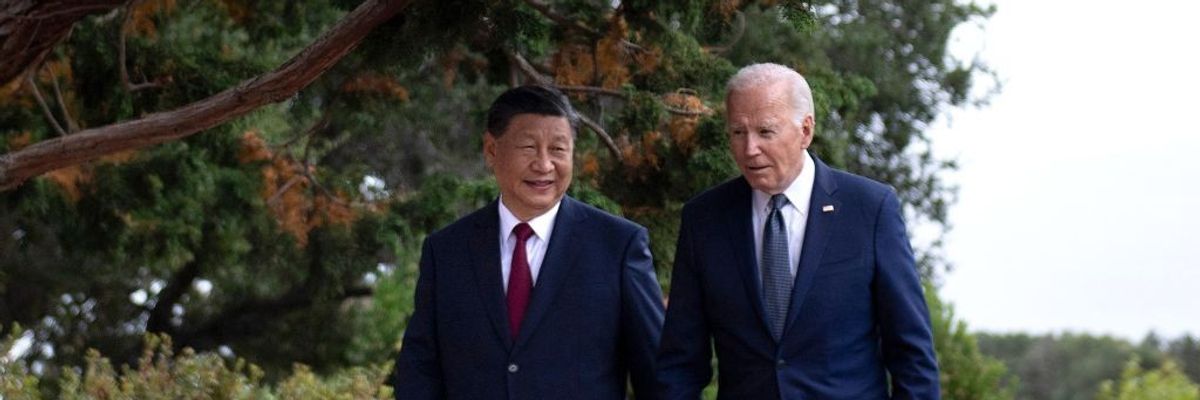
President Joe Biden and Chinese President Xi Jinping met in California this week in their first meeting in person in over a year. The two countries released a joint climate statement this week and committed to work together more closely to fight climate change.
World leaders are also gathering this week in Nairobi, Kenya, at the United Nation’s Third Session (INC-3) to craft an ambitious Global Plastics Treaty to end plastic pollution. This is a huge opportunity to show the world what the U.S. and China can do to address climate change, phase out fossil fuels, and end all forms of plastic pollution in every stage of the life cycle.
This week’s statement reaffirmed their commitment to address climate change, and to end plastic pollution and work together and with others to develop an internationally legally binding instrument. On both climate and plastics, it is critical that the U.S. and China work with the rest of the world.
The ongoing negotiations for the plastics treaty are a unique opportunity to show how the ambitious targets for net-zero emissions set by U.S. and China can be translated to an effective international agreement focusing on one of the most emissions-intensive industries.
Scientists, including myself, have demonstrated the connection between unsustainable production and consumption of plastics and the climate crisis. Plastics are a fully integrated link of the fossil fuel value chain—99% of plastics are derived from fossil fuels, primarily oil and gas fractions—as well as a core and growing business of many of the largest fossil fuel firms. This has in recent years led to a deeper fossil fuel lock-in for plastics. Plastics are associated with around 5% of global greenhouse gas emissions (GHG), and this share is expected to grow rapidly in the coming decades if projections for continued growth of plastic production materialize.
Of particular concern is the rapid growth of plastic production in countries and regions with energy systems and plastic feedstocks that use coal, leading to GHG emissions from plastics production growing at a higher rate than production itself. Plastic producers have very limited targets and programs for reducing their GHG emissions such as through renewable energy. And necessary long-term targets for eliminating the use of fossil fuel feedstocks are completely absent. So far international climate policy has largely ignored the need to phase out fossil fuels for both energy and plastic feedstocks.
It is clear that one of the most effective ways of mitigating climate change impacts as well as all other forms of pollution associated with plastics is to restrict future production. This has been identified by scientists as a central goal for the Global Plastics Treaty and is one of the key requirements for the treaty emphasized by the global Scientists’ Coalition for an Effective Plastics Treaty.
Civil society organizations and business leaders from around the world agree, and have rallied around a call for a treaty that prioritizes production reduction. And they have pointed out that the treaty is too focused on downstream measures which will be inadequate for meeting the challenge.
With China and the U.S. taking steps towards a more internationally harmonized agenda on climate change mitigation, we would expect these leading plastic producer countries to also show leadership in relation to plastics. The ongoing negotiations for the plastics treaty are a unique opportunity to show how the ambitious targets for net-zero emissions set by U.S. and China can be translated to an effective international agreement focusing on one of the most emissions-intensive industries.
It is imperative, for the climate as well as both terrestrial and marine ecosystems, that the plastics treaty addresses the full life cycle of plastics through measures and interventions in production, consumption, and end-of-life management.
This post was originally published on Common Dreams.
-
Norzin Dolma said government should sanction Chinese officials for ‘threatening the very existence … of Tibetan identity’
Australia must not compromise on human rights as it improves its relationship with China because “the truth must be told”, a minister from the Tibetan government in exile has said during a visit to Canberra.
Norzin Dolma, a minister of the Central Tibetan Administration based in Dharamshala in India, met Australian MPs from across the political spectrum on Thursday to warn against a “quiet diplomacy” approach to “gross human rights abuses” and “brutal suppression” in Tibet.
Continue reading…This post was originally published on Human rights | The Guardian.
-
7 Mins Read
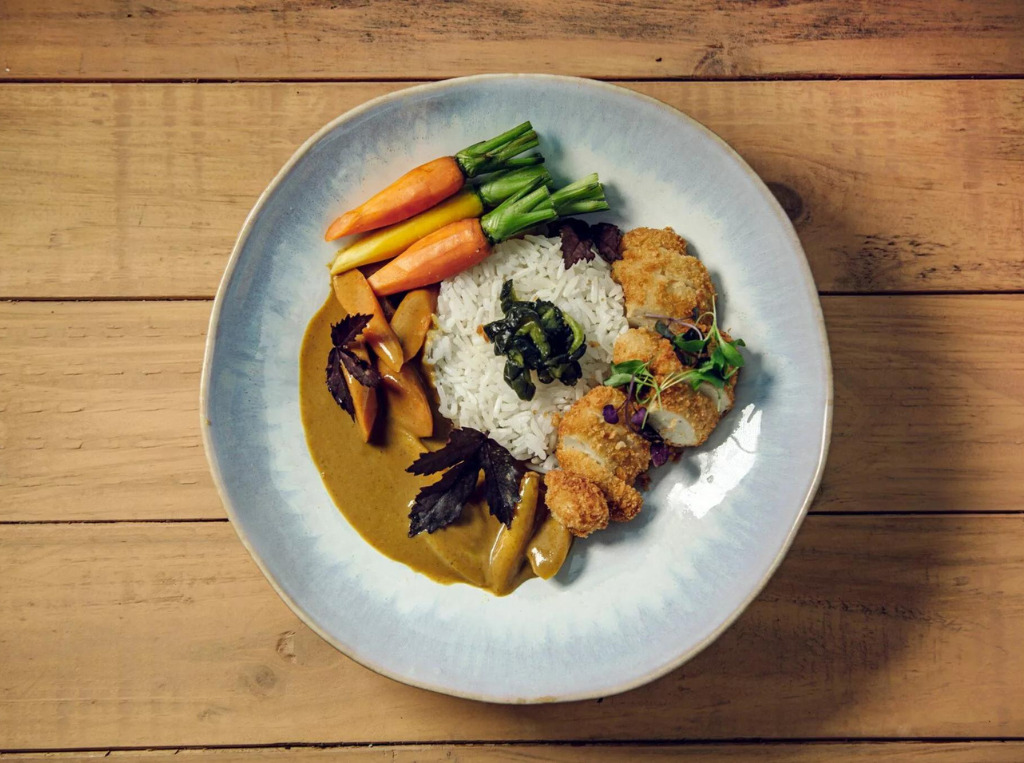
The Good Food Institute (GFI) APAC’s first State of the Industry report highlights the funding rollercoaster that is alt-protein, Singapore’s reputation as an innovation launchpad, barriers to the adoption of plant-based meat, and the receptiveness to blended meat products. Plus, a separate report by GFI showcases the potential of sidestream valorisation.
GFI APAC launched its first State of the Industry report last week, showcasing alt-protein’s tremendous potential and heightened challenges in Asia-Pacific. The think tank explores the investment gap in the sector, describes the importance of scaling up and presents a consumer survey showcasing interesting results and opportunities for alt-protein producers, including those working with blended meat.
Here are the key takeaways:
APAC private alt-protein investment reached a high, then fell off a cliff

Courtesy: GFI APAC 2022 was a record year for alt-protein financing in the region. Public funding increased by 207% from 2021, from $31M to $94M. This sum was actually 37% higher than the all-time total up to 2021 ($68M). The current total ($162M) accounts for 16% of all alt-protein investments globally.
Similarly, at $551M, private financing was up by 45% year-on-year, surpassing $1B in all-time funding. But the sector was also affected by the global downturn in VC funding, which reached a 13-quarter low, with the first half of 2023 only witnessing $47M in investment.
After surpassing Australia/New Zealand in funding last year, Singapore has now given way to the Antipodean nations when it comes to investments in the first half of 2023. Australia and New Zealand garnered $20M in funding, followed by South Korea ($13M), mainland China ($8M) and then Singapore ($3M).
APAC’s business ecosystem is growing rapidly
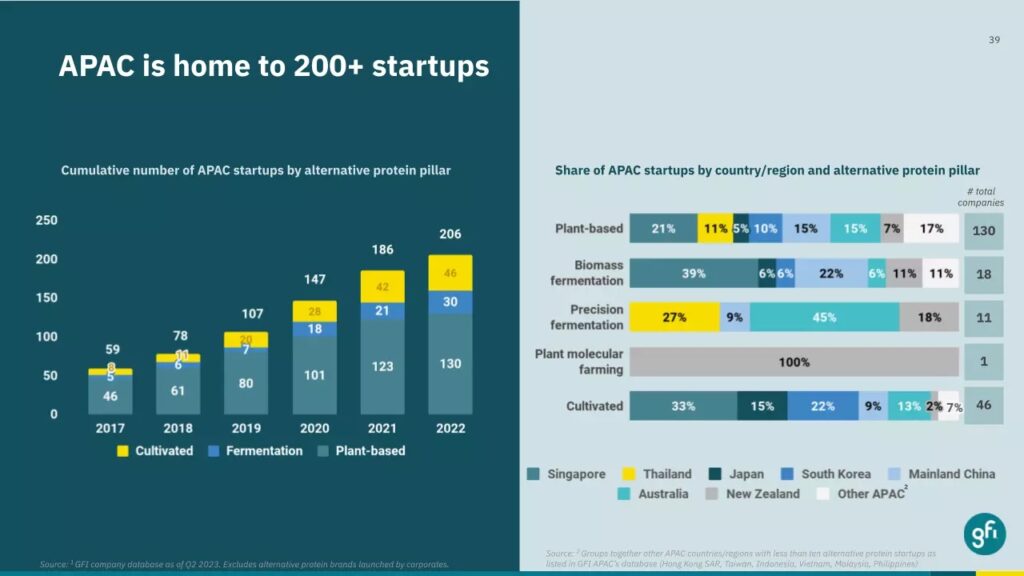
Courtesy: GFI APAC There are now at least 206 startups working with alternative proteins in APAC, with 20 launching just last year. Interestingly, most of these new startups from 2022 are focused on B2B rather than B2C, which is an inversion from earlier years.
Of the 206, 130 companies belong to the plant-based pillar, 46 in the cultivated meat space, and 30 in fermentation. Australia (45%) leads the region in terms of precision fermentation startups – like Eden Brew, Cauldron and All G Foods – followed by Thailand (27%). Singapore, meanwhile, is home to the highest number of biomass fermentation (39%), cultivated (33%) and plant-based (21%) startups in APAC.
Singapore is a testbed for R&D exports
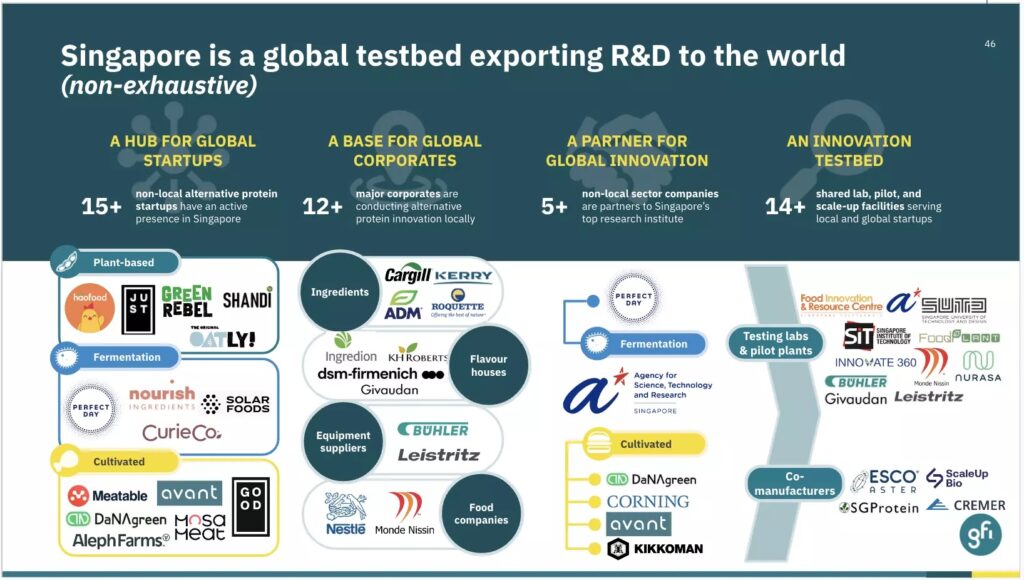
Courtesy: GFI APAC Despite the decline in private funding, Singapore remains a “global testbed” for the region, helping producers incubate, innovate, partner, and export their alt-protein offerings internationally. At least 25 non-local companies have a presence in the island state for R&D and business development, while it’s home to almost a quarter (24%) of all alt-protein startups in APAC.
Shared R&D facilities and progressive regulatory frameworks are enabling companies to scale up their products and conduct market tests. The country was the first in the world to approve the sale of cultivated meat, and these feats are why its trade minister Alvin Tan dubbed it “the best place in the world for food innovation”.
Alt-protein needs $10B of investment – per year
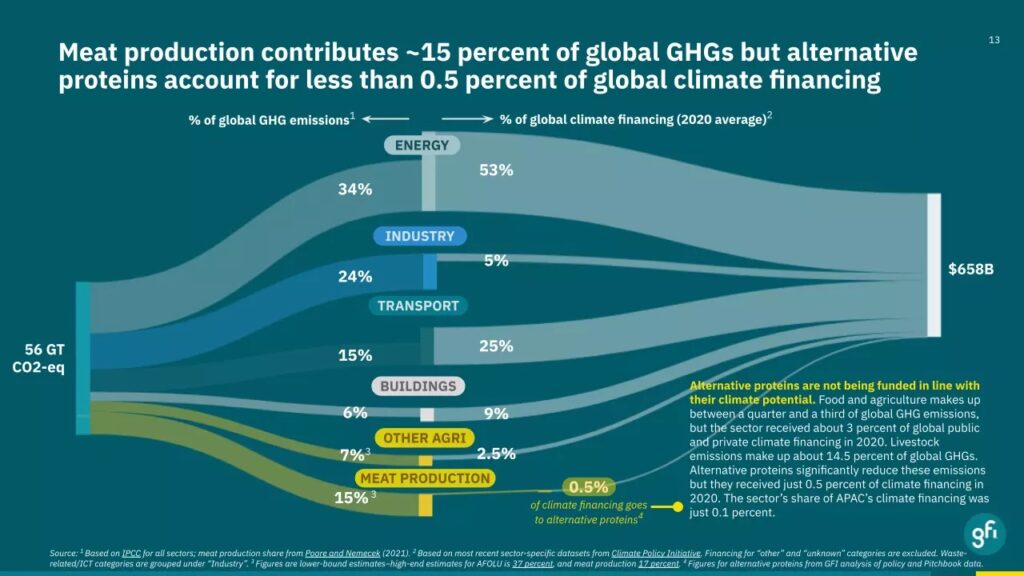
Courtesy: GFI APAC Despite the record public funding numbers, alt-protein’s share of funding is minuscule when looking at it more closely. GFI APAC cited data from the Climate Policy Initiative from 2022, which revealed that only about 3% of all climate finance goes to agrifood systems (that has minutely risen to 4.3% this year).
According to GFI APAC, alt-protein only represents 0.5% of that share (with APAC making up 0.1%), despite these foods significantly reducing the impact of food on the environment, which accounts for a third of all emissions. For example, a study earlier this year found that veganism can cut emissions, land use and water pollution by 75% compared to meat-rich diets.
The report estimates that if funding for alt-protein could capture just 8% of the global meat market by 2030, the reduction in GHG emissions would be equivalent to decarbonising 95% of the aviation sector, adding that “unlocking the full benefits” of alternative proteins will require about $10.1B in public funding annually.
Overcoming scale-up challenges is key

Courtesy: GFI APAC The report states that there’s an urgent need to address the alt-proteins scale-up barriers, which is key to achieving mass production and price parity with conventional proteins: “Building factories cheaply and proving demand in early markets will help to make scale-up more affordable, easier to finance, and lower risk.”
Co-manufacturing organisations can further support efficient scaling-up, and Singapore has established the platform for derisking early scale-ups, with companies like Esco Aster and SGProtein leading the way. And while first-movers are exploring the scaling advantages of other APAC countries for later-stage co-manufacturing, there are significant gaps in the region’s scaling capacity. The report says that considerably more alt-protein tech facilities are needed across scales, especially demonstration, first-of-a-kind, and commercially proven plants.
Consumers want to try more plant-based meat, but barriers keep them at bay
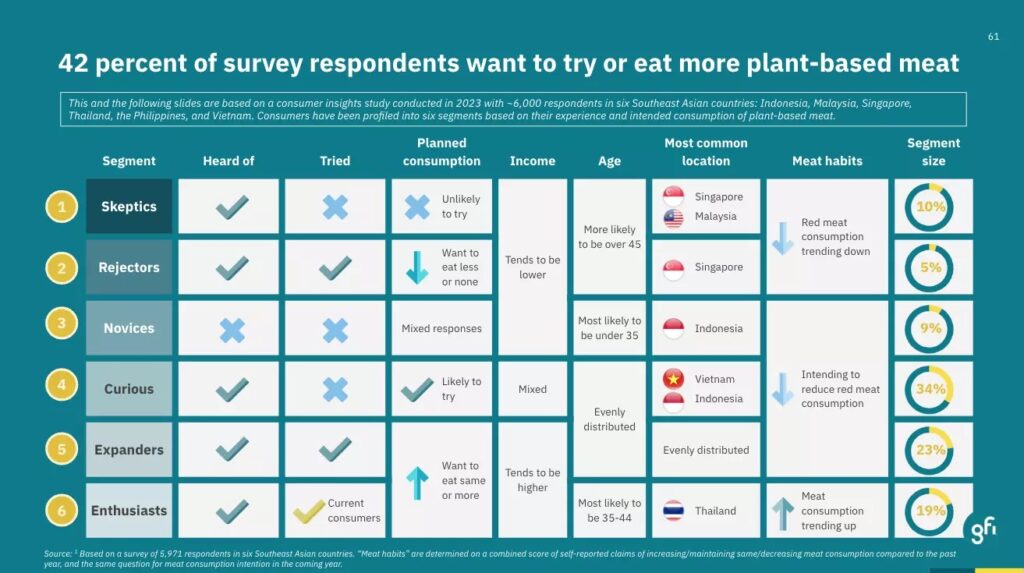
Courtesy: GFI APAC The report also published results of a six-country, 5,971-person survey about plant-based meat, dividing participants into sceptics, rejectors, novices, curious, expanders and enthusiasts based on their responses. Thailand seems to be the most receptive to plant-based meat, while Singapore surprisingly has the highest number of sceptics (unlikely to try) and rejectors (who want to lower their alt-meat intake).
Like the US and Europe, health is the biggest driver of plant-based meat intake for Asian consumers too, followed by taste and affordability. But when it comes to barriers of consumption, this is flipped, as price takes top priority, followed by nutrition and flavour.
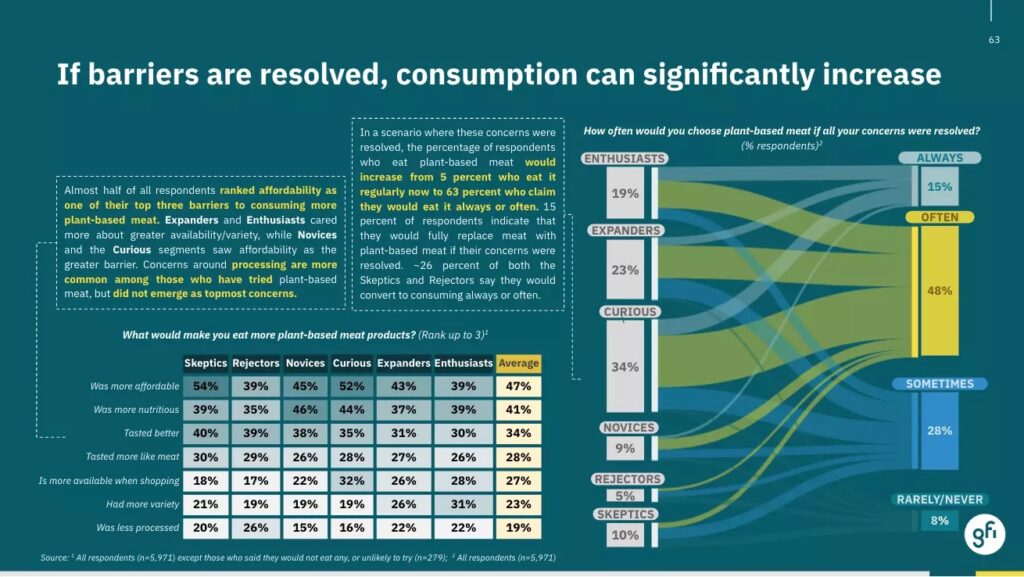
Courtesy: GFI APAC If they were more affordable, nutritious and better-tasting, it would increase the number of APAC consumers who eat meat alternatives from 5% to 63%. And 15% of these respondents say they would fully replace conventional meat with plant-based if their concerns are alleviated – highlighting a massive growth opportunity for brands in this space.
Flexitarians are also key for these companies. Plant-based sceptics and novices are also the groups that consume meat the lowest, while meat intake is trending up for enthusiasts, who are the current buyers and represent higher-income consumers. This means that the people who eat the most plant-based meat also consume conventional meat more often than the rest.
Blended meat is of high interest – especially to vegan sceptics
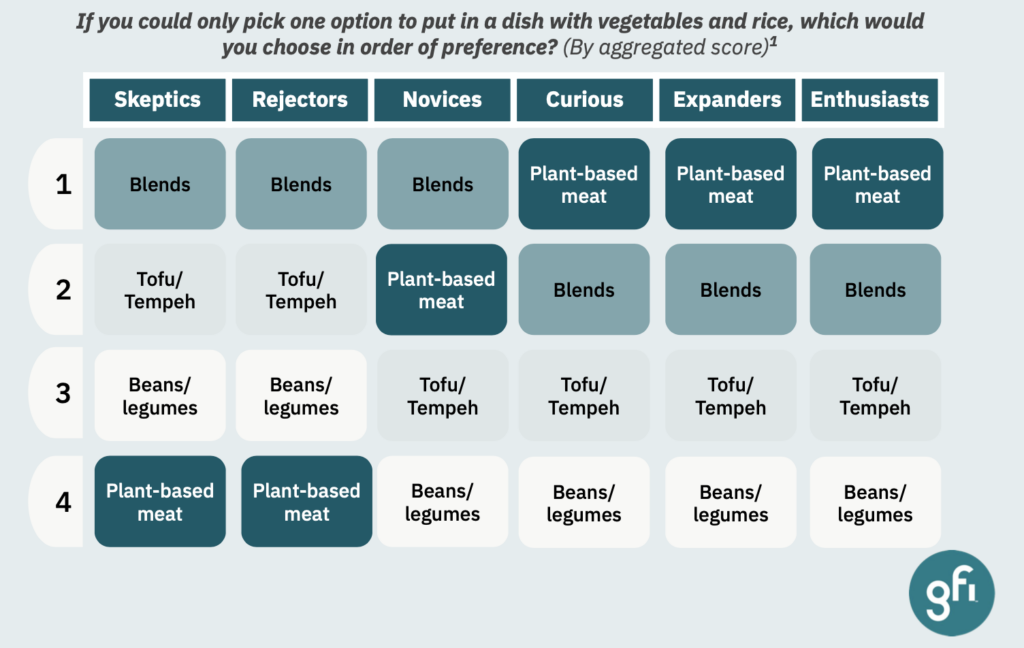
Courtesy: GFI APAC Blended meat products – which combine plant-based ingredients and proteins with animal-derived meat – are on the up right now. A majority of consumers (93%) showed at least some interest in these foods, with over half saying they’re very interested.
Notably, almost two-thirds of sceptics and rejectors showed some interest in blended meat, with nearly a fifth of the latter very interested. Enthusiasts were the most interested, reflecting their wishes for diverse protein options.
When presented with an option to choose from tofu/tempeh, beans/legumes, plant-based meat and blended meat, the groups that eat vegan meat alternatives the least – sceptics, rejectors and novices – placed blended meat on top, while the former two put plant-based at the bottom. For the rest, plant-based meat leads the way, but blended meat comes second.
This reflects the potential of blended meat to flip the perception of consumers apprehensive of plant-based meat, and help them move towards lower meat consumption.
Sidestream valorisation could advance alt-protein
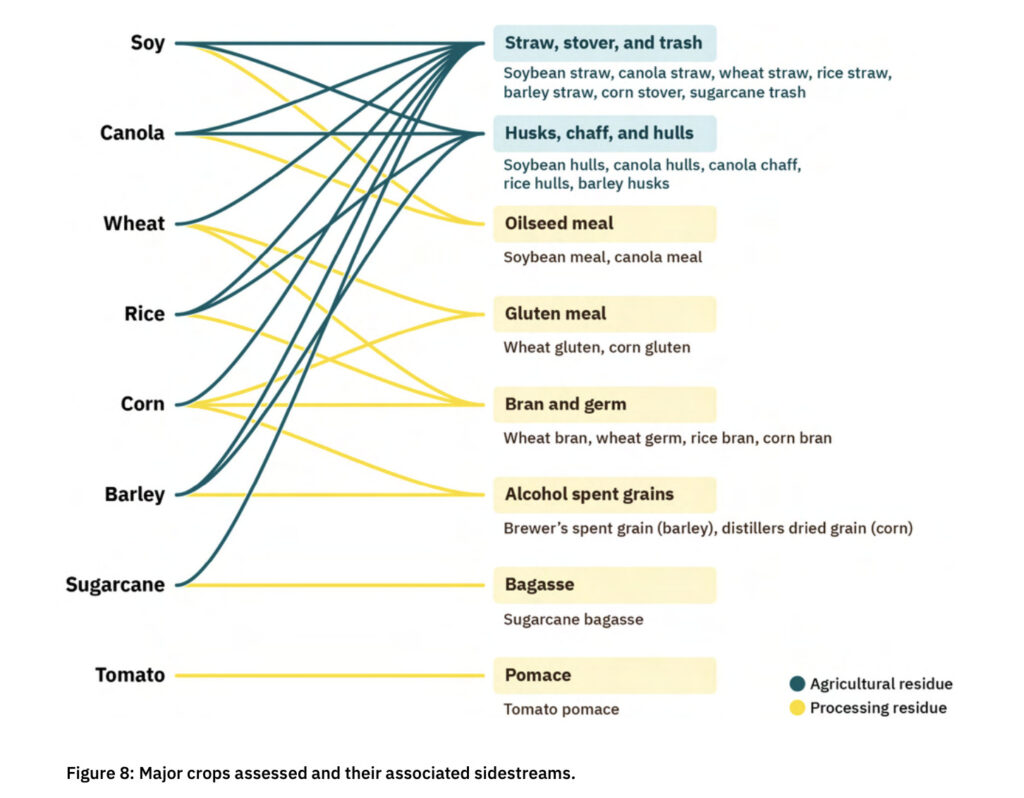
Courtesy: GFI In a separate report by GFI’s US division, the think tank analysed eight high-volume crop sidestreams in the US, Canada and Mexico to determine which has the highest potential for plant-based, fermented and cultivated protein ingredients.
Soy meal (commonly used as animal feed), tomato pomace and canola meal were ranked as the crops most ideal for sidestream valorisation to make protein concentrates for plant-based products. Soy meal also ranked as the top crop to upcycle for protein hydrolysates for fermentation and cultured meat media – developing this sidestream could help tackle the cost and scale-up challenges mentioned above.
For fermentation-based proteins – specifically lignocellulosic-derived sugars – corn stover was earmarked as the most useful sidestream, followed by soy straw, rice hulls and sugarcane trash. All these crops were measured against criteria like production volume and cost, environmental credentials, and functional attributes.
“We currently produce significant amounts of waste due to low-value utilisation and disposal of things like agricultural residues, processing side chains and food losses generated throughout the supply chain,” said Lucas Eastham, a senior fermentation scientist at GFI. “The valorisation or the upcycling of agricultural and processing side streams presents an opportunity for us to shape the circular bioeconomy, and this will help us reduce waste and increase food production.”
TLDR: to reach its full potential in APAC, alt-protein needs significantly higher public and private investment, better taste, nutrition and prices, more facilities to derisk scaling up, and higher sidestream valorisation.
The post ‘The Centre of Challenges & Solutions’: 7 Alt-Protein Takeaways from GFI APAC’s State of the Industry Report 2023 appeared first on Green Queen.
This post was originally published on Green Queen.
-
UNITED NATIONS: Against the backdrop of relentless Israeli attacks on Gaza, the UN High Representative for Disarmament Affairs, Izumi Nakamitsu, has warned of a dangerous expansion of the conflict in the wider region at a conference on the establishment of a Middle East zone free of nuclear weapons, according to APP.
Ms. Nakamitsu, addressing the opening session of the conference on behalf of UN Secretary-General Antonio Guterres, said she came to the Conference “with a heavy heart, anguish, pain and sorrow that I had never felt in my more than 30 years of UN career.” She noted the minute of silence among UN personnel to mourn and honour the 101 brave colleagues from the United Nations Relief and Works Agency for Palestine Refugees in the Near East (UNRWA) who have lost their lives in Gaza in service of others.
During her address to the Conference last year, she spoke of the increasing geopolitical tensions and conflicts in the world and the strain on multilateral disarmament and non-proliferation regimes, she said. “A year on, we are witnessing a crisis of humanity unfolding in front of our eyes in Gaza,” she said.
The geopolitical and security situation has worsened and relations among major powers have further strained, Ms. Nakamitsu noted.
She expressed deep concern about clear violations of international humanitarian law in the ongoing conflict.
“Let me repeat the clear, unequivocal position of the United Nations that no party to an armed conflict is above international humanitarian law. Even wars have rules,” she said, calling for an immediate humanitarian ceasefire to allow for life-saving aid to reach those in urgent and desperate need.
“Cool heads and diplomatic efforts must prevail,” she said, emphasizing that no effort should be spared to help pave the way to peace, to a two-State solution with Israelis and Palestinians living in peace and security.
Addressing the root causes of the conflict, including through a broader peace and security architecture in the region, is urgent, Ms. Nakamitsu said.
Given the current crisis in the Middle East, the decision to continue the important work of the Conference demonstrates a collective will to use dialogue and diplomacy in seeking common security and regional peace.
“Any threat to use nuclear weapons is inadmissible [and] further illustrates the urgency and imperative to achieve the objective of a Middle East zone free of nuclear weapons and other weapons of mass destruction,” she said.
The current session will continue to address key issues for a future Middle East zone treaty. The importance of effective verification cannot be understated, as it ensures compliance and fosters trust among the parties to a future zone, she said.
“The path towards the establishment of a Middle East zone through the elaboration of a legally binding treaty will not be smooth sailing,” she said. But the incremental approach of the Conference is working well in preparing States for future negotiation of a treaty, she added, reiterating a call for the full participation of all States in the region. “A Middle East zone free of nuclear weapons and other weapons of mass destruction will significantly contribute […] to peace and security of the Middle East and beyond,” she said.
Opening the conference, the President of the fourth session of the Conference, Taher El-Sonni of Libya, said the crisis in Gaza and its unpredictable backlash for peace and security in the Middle East and beyond underscores the urgency of the work of the Conference.
“The grave violations by the Israeli occupation forces must come to an end immediately,” he said. “As long as there are nuclear weapons and other WMDs (weapons of mass destruction) in our region, there will be no hope for sustainable peace in our region,” he said, adding that the provocative statement by a representative of the Israeli Government a few days ago, threatening the use of nuclear weapons against Gaza, is unacceptable.
The Conference and all parts of the United Nations must condemn that threat, which proves the gravity of the situation, he said.
The President of the General Assembly, Dennis Francis, noted that over four decades ago, the Assembly recommended the establishment of a nuclear-free zone in the Middle East.
“The ardent hope for a safer future has not been lost on the sands of time,” he said, highlighting that only two weeks ago, the First Committee (Disarmament and International Security) reaffirmed its unflinching support for the establishment of this zone, calling for urgent and practical steps for implementation.
The post Escalating Israeli attacks on Gaza could spread conflict to wider region, UN official warns first appeared on VOSA.
